Paul van Yperen's Blog, page 407
September 11, 2014
Oscar Beregi, Sr.
Hungarian stage and film actor Oscar Beregi, Sr. (1876-1965) appeared in 27 European and American films between 1916 and 1953. He is best remembered as Dr. Baum in Fritz Lang’s Das Testament des Dr. Mabuse (1933).
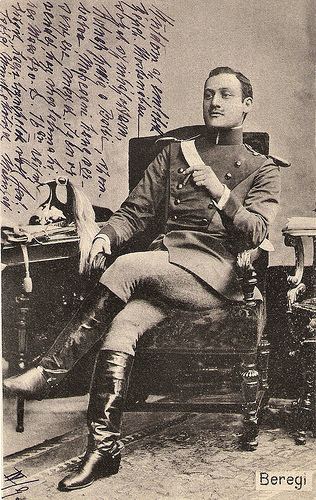
Hungarian postcard by S.S.Bpt., no. 235.
An attack on the aristocracy
Oscar Beregi, Sr. was born Beregi Oszkár or Oszkár Beregi (according to Wikipedia ) or as Berger Oszkár (according to IMDb ) in Budapest, Austria-Hungary, in 1876.
In the 1910s, he was the leading actor of the National Theatre in Budapest, and would later perform in plays in Vienna and Berlin.
The sources differ about Beregi’s film debut in 1916. Was it with the lead role in the silent Hungarian production Mire megvénülünk/The time we get old (Ödön Uher ifj., 1916) or with the male lead in Hófehérke/Snowwhite (Márton Garas, 1916) with Ica von Lenkeffy?
A year later he starred in the drama A Gólyakalifa/The Stork Caliph (Korda Sándor a.k.a. Alexander Korda, 1917), co-starring Gyula Bartos and Judit Bánky. It was the second film made by the legendary director-producer for his newly established Corvin Film company. Korda pulled off what was considered a literary coup by persuading the author Mihály Babits to allow him to film a version of his 1916 novel of the same name.
Two years later, Beregi appeared in another drama by Korda, Ave Caesar! (Alexander Korda, 1919) with Gábor Rajnay and María Corda . The film tells the story of a debauched Habsburg Prince, who sends out one of his aide-de-camps to bring him back a gypsy girl.
Ave Caesar! was considered as an attack on the aristocracy. It was made by Korda for the state-owned film industry during the Hungarian Soviet Republic. Once the regime fell later that year Korda was arrested and eventually compelled to leave Hungary as part of the White Terror.
Beregi also worked with another Hungarian who would later become famous in Hollywood, Mihaly Kertész (later known as Michael Curtiz), on the drama Jön az öcsém/My Brother is Coming (Mihaly Kertész, 1919) with Lucy Doraine .
Like many other Hungarian film makers, Oscar Beregi, Sr. fled with his family the Béla-Kun-Regime and moved to Austria. There he appeared as Cesare Borgia in Meriota, die Tänzerin/Neriota – the dancer (Julius Herska, 1922) opposite Maria Mindzenty as Meriota and Nora Gregor as Lucrezia Borgia.
Later he played Amenmeses opposite María Corda in the epic Die Sklavenkönigin/The Moon of Israel (Mihaly Kertész, 1924), produced by Sascha Kolowrat-Krakowsky and Arnold Pressburger. The script was written by Ladislaus Vajda, based on H. Rider Haggard's novel Moon of Israel, which in its turn was inspired by the Biblical story of the Exodus.
Shooting took place in Vienna with about 5,000 extras, in the studios of Sascha-Film, and outdoors on the Laaer Berg. Vienna was touted as 'the Hollywood of Europe,' and the film brought Kertész to the attention of the American studio head Jack Warner. Warner invited Kertész to Hollywood in 1926, where he rapidly became Michael Curtiz and made a career with the Warner Studios.
Die Sklavenkönigin was entirely lost for many years, but in 2005 the film was restored and re-copied by the Filmarchiv Austria and presented in the Wiener Metro Kino.
Beregi then starred in the drama Der Fluch/The Curse (Robert Land, 1924). The film marked the screen debut of Lilian Harvey as a young Jewish women in an Eastern European shtetl, who struggles to reconcile her aspirations with her duty to her family. As her lifestyle grows wilder, her mother is shocked by her immoral behaviour and commits suicide by drowning - repeating ‘the curse’ which has haunted the family for centuries.
He also starred in Austrian-Polish coproduction Ssanin (Friedrich Feher, 1924) with Magda Sonja , and the Jewish production Jiskor (Sidney M. Goldin, 1924) with Maurice Schwartz and Dagny Servaes .
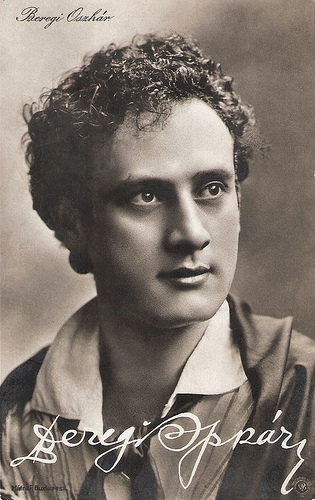
German postcard by NPG. Photo: Mátrai, Budapest.
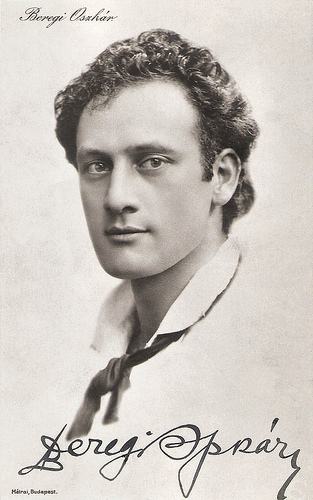
Hungarian postcard. Photo: Mátrai, Budapest.
A menace to public health and safety
From 1926 on, Oscar Beregi, Sr. appeared in several Hollywood films, including the romantic comedies The Love Thief (John McDermott, 1926) and Butterflies in the Rain (Edward Sloman, 1926), with Laura La Plante.
He also had a supporting part in the silent drama The Flaming Forest (Reginald Barker, 1926) starring Antonio Moreno and Renée Adorée. The film is remarkable while a two-strip Technicolor sequence was shot for the climactic blaze sequence of the film.
When the sound film was introduced in Hollywood, Beregi’s possibilities as an actor were limited and he returned to Europe. He appeared there in several Hungarian films, but he is best remembered for his performance as Dr. Baum in Das Testament des Dr. Mabuse/The Testament of Dr. Mabuse (Fritz Lang, 1933).
This German crime film is a sound sequel to Lang's silent film Dr. Mabuse der Spieler/Dr. Mabuse the Gambler (Fritz Lang, 1922) and features Rudolf Klein-Rogge as Dr. Mabuse who is in an insane asylum where he is found frantically writing his crime plans. When Mabuse's criminal plans begin to be implemented, Inspector Lohmann (Otto Wernicke) tries to find the solution with clues from the gangster Thomas, the institutionalized Hofmeister and Professor Baum (Beregi) who becomes obsessed with Dr. Mabuse.
According to Wikipedia , the film was scheduled for release on 24 March 1933 at the UFA-Palast am Zoo, but Adolf Hitler came to power at the end of January 1933 and on 14 March, Hitler established the new Ministry of Public Enlightenment and Propaganda headed by Joseph Goebbels. By 30 March, the Ministry of Propaganda banned Das Testament des Dr. Mabuse as a menace to public health and safety. Goebbels stated that he would not accept the film as it "showed that an extremely dedicated group of people are perfectly capable of overthrowing any state with violence".
On the French release, The New York Times wrote that "It is the French version of Fritz Lang's production, Le Testament du Dr. Mabuse (Dr. Mabuse's Will). It is a hallucinating and horrifying story, depicted with great power and the extraordinary beauty of photography that Lang has led his admirers to expect."
During the Third Reich he lived in Budapest. Because of the anti-Semitic laws of 1939, he was only allowed to work as a stage actor in Omike, and he just barely escaped the Holocaust.
In the late 1940s, he emigrated to the US where he played a supporting role in the Oscar-winning film Call Me Madam (Walter Lang, 1953) starring Ethel Merman.
Oscar Beregi, Sr. died in 1965 in Hollywood, California. He was the father of actor Oscar Beregi, Jr., who also worked as a film and TV actor in Hollywood.
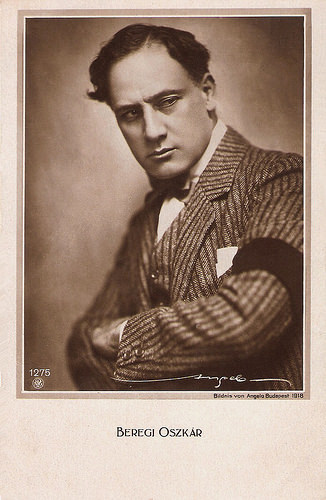
German postcard by NPG, no. 1275 Photo: Angelo, Budapest, 1918.
Sources: Daniel Rudolf (Ralph’s Cinema Trek), Wikipedia (English and German), and .

Hungarian postcard by S.S.Bpt., no. 235.
An attack on the aristocracy
Oscar Beregi, Sr. was born Beregi Oszkár or Oszkár Beregi (according to Wikipedia ) or as Berger Oszkár (according to IMDb ) in Budapest, Austria-Hungary, in 1876.
In the 1910s, he was the leading actor of the National Theatre in Budapest, and would later perform in plays in Vienna and Berlin.
The sources differ about Beregi’s film debut in 1916. Was it with the lead role in the silent Hungarian production Mire megvénülünk/The time we get old (Ödön Uher ifj., 1916) or with the male lead in Hófehérke/Snowwhite (Márton Garas, 1916) with Ica von Lenkeffy?
A year later he starred in the drama A Gólyakalifa/The Stork Caliph (Korda Sándor a.k.a. Alexander Korda, 1917), co-starring Gyula Bartos and Judit Bánky. It was the second film made by the legendary director-producer for his newly established Corvin Film company. Korda pulled off what was considered a literary coup by persuading the author Mihály Babits to allow him to film a version of his 1916 novel of the same name.
Two years later, Beregi appeared in another drama by Korda, Ave Caesar! (Alexander Korda, 1919) with Gábor Rajnay and María Corda . The film tells the story of a debauched Habsburg Prince, who sends out one of his aide-de-camps to bring him back a gypsy girl.
Ave Caesar! was considered as an attack on the aristocracy. It was made by Korda for the state-owned film industry during the Hungarian Soviet Republic. Once the regime fell later that year Korda was arrested and eventually compelled to leave Hungary as part of the White Terror.
Beregi also worked with another Hungarian who would later become famous in Hollywood, Mihaly Kertész (later known as Michael Curtiz), on the drama Jön az öcsém/My Brother is Coming (Mihaly Kertész, 1919) with Lucy Doraine .
Like many other Hungarian film makers, Oscar Beregi, Sr. fled with his family the Béla-Kun-Regime and moved to Austria. There he appeared as Cesare Borgia in Meriota, die Tänzerin/Neriota – the dancer (Julius Herska, 1922) opposite Maria Mindzenty as Meriota and Nora Gregor as Lucrezia Borgia.
Later he played Amenmeses opposite María Corda in the epic Die Sklavenkönigin/The Moon of Israel (Mihaly Kertész, 1924), produced by Sascha Kolowrat-Krakowsky and Arnold Pressburger. The script was written by Ladislaus Vajda, based on H. Rider Haggard's novel Moon of Israel, which in its turn was inspired by the Biblical story of the Exodus.
Shooting took place in Vienna with about 5,000 extras, in the studios of Sascha-Film, and outdoors on the Laaer Berg. Vienna was touted as 'the Hollywood of Europe,' and the film brought Kertész to the attention of the American studio head Jack Warner. Warner invited Kertész to Hollywood in 1926, where he rapidly became Michael Curtiz and made a career with the Warner Studios.
Die Sklavenkönigin was entirely lost for many years, but in 2005 the film was restored and re-copied by the Filmarchiv Austria and presented in the Wiener Metro Kino.
Beregi then starred in the drama Der Fluch/The Curse (Robert Land, 1924). The film marked the screen debut of Lilian Harvey as a young Jewish women in an Eastern European shtetl, who struggles to reconcile her aspirations with her duty to her family. As her lifestyle grows wilder, her mother is shocked by her immoral behaviour and commits suicide by drowning - repeating ‘the curse’ which has haunted the family for centuries.
He also starred in Austrian-Polish coproduction Ssanin (Friedrich Feher, 1924) with Magda Sonja , and the Jewish production Jiskor (Sidney M. Goldin, 1924) with Maurice Schwartz and Dagny Servaes .

German postcard by NPG. Photo: Mátrai, Budapest.

Hungarian postcard. Photo: Mátrai, Budapest.
A menace to public health and safety
From 1926 on, Oscar Beregi, Sr. appeared in several Hollywood films, including the romantic comedies The Love Thief (John McDermott, 1926) and Butterflies in the Rain (Edward Sloman, 1926), with Laura La Plante.
He also had a supporting part in the silent drama The Flaming Forest (Reginald Barker, 1926) starring Antonio Moreno and Renée Adorée. The film is remarkable while a two-strip Technicolor sequence was shot for the climactic blaze sequence of the film.
When the sound film was introduced in Hollywood, Beregi’s possibilities as an actor were limited and he returned to Europe. He appeared there in several Hungarian films, but he is best remembered for his performance as Dr. Baum in Das Testament des Dr. Mabuse/The Testament of Dr. Mabuse (Fritz Lang, 1933).
This German crime film is a sound sequel to Lang's silent film Dr. Mabuse der Spieler/Dr. Mabuse the Gambler (Fritz Lang, 1922) and features Rudolf Klein-Rogge as Dr. Mabuse who is in an insane asylum where he is found frantically writing his crime plans. When Mabuse's criminal plans begin to be implemented, Inspector Lohmann (Otto Wernicke) tries to find the solution with clues from the gangster Thomas, the institutionalized Hofmeister and Professor Baum (Beregi) who becomes obsessed with Dr. Mabuse.
According to Wikipedia , the film was scheduled for release on 24 March 1933 at the UFA-Palast am Zoo, but Adolf Hitler came to power at the end of January 1933 and on 14 March, Hitler established the new Ministry of Public Enlightenment and Propaganda headed by Joseph Goebbels. By 30 March, the Ministry of Propaganda banned Das Testament des Dr. Mabuse as a menace to public health and safety. Goebbels stated that he would not accept the film as it "showed that an extremely dedicated group of people are perfectly capable of overthrowing any state with violence".
On the French release, The New York Times wrote that "It is the French version of Fritz Lang's production, Le Testament du Dr. Mabuse (Dr. Mabuse's Will). It is a hallucinating and horrifying story, depicted with great power and the extraordinary beauty of photography that Lang has led his admirers to expect."
During the Third Reich he lived in Budapest. Because of the anti-Semitic laws of 1939, he was only allowed to work as a stage actor in Omike, and he just barely escaped the Holocaust.
In the late 1940s, he emigrated to the US where he played a supporting role in the Oscar-winning film Call Me Madam (Walter Lang, 1953) starring Ethel Merman.
Oscar Beregi, Sr. died in 1965 in Hollywood, California. He was the father of actor Oscar Beregi, Jr., who also worked as a film and TV actor in Hollywood.

German postcard by NPG, no. 1275 Photo: Angelo, Budapest, 1918.
Sources: Daniel Rudolf (Ralph’s Cinema Trek), Wikipedia (English and German), and .
Published on September 11, 2014 23:00
I.M. Joachim Fuchsberger (1927-2014)
Today, German actor and television host Joachim Fuchsberger passed away. He died of organ failure at his German home in Grünwald near Munich. Fuchsberger has starred in around 90 films, and was the presenter of more than 500 TV programmes. He became one of the biggest stars of German mainstream cinema with the Edgar Wallace films of the 1960s. He always played one of the good guys, often an inspector from Scotland Yard. 'Blacky' Fuchsberger was 87.
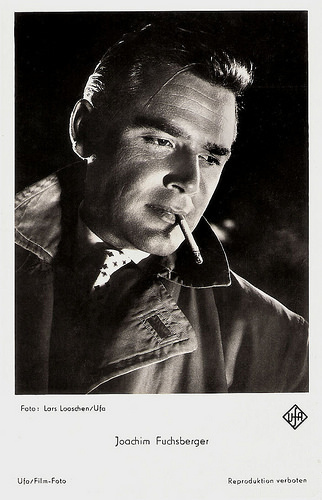
German postcard by Ufa, Berlin-Tempelhof, no. FK 3981. Photo: Lars Looschen / Ufa.
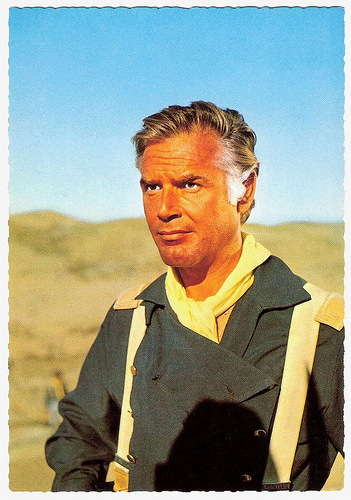
German postcard, no. 10 of 64. Photo: Constantin. Still from Der Letzte Mohikaner/The Last Tomahawk (1965, Harald Reinl).
Blacky
Joachim ‘Blacky’ Fuchsberger was born in 1927 in Zuffenhausen, today a district of Stuttgart, Germany. He went to secondary school in Heidelberg but was then drafted for the Reich Labour Service and became a parachutist at the Eastern front at the end of the war.
After British war captivity, In 1946 he worked as a coal miner for the British in Recklinghausen. His nickname Blacky, which has been incessantly used by the media, hails from that time. Fuchsberger worked in several jobs as mechanic and conferencier.
In 1950 he began his career in the media, first as a radio announcer at the Bayerischen Rundfunk (Bavarian radio) it kicked off of an unexpected career. From 1953 on, he appeared in several supporting roles in films like Geh mach dein Fensterl auf/Go Open Your Window (Anton Kutter, 1953).
Fuchsberger had his breakthrough in the 08/15 trilogy (Paul May, 1954-1955) based on Hans Hellmut Kirst's novels. His part as Wehrmacht private Asch was followed by several other parts in war films, including U47 - Kapitänleutnant Prien/U-47 Lt. Commander Prien (Harald Reinl, 1958).
Fuchsberger also often appeared as the young lover. The attractive actor did many women's hearts beat faster in light entertainment films like Symphonie in Gold/Symphony in Gold (Franz Antel, 1956), Die Zwillinge vom Zillertal/The twins from the Zillertal (Harald Reinl, 1957) with Isa and Jutta Günther, and Mein Schatz ist aus Tirol/My treasure is from Tirol (Hans Quest, 1958) with Marianne Hold .
In 1959 he starred in Der Frosch mit der Maske/Face of the Frog (Harald Reinl, 1959), playing amateur detective Richard Gordon. More than 3.2 million visitors saw the thriller based on a novel by Edgar Wallace, in the cinema.
This surprising success laid the foundation for 12 other film adaptations of Edgar Wallace mysteries, including Die toten Augen von London/Dead Eyes of London (Alfred Vohrer, 1962) with Karin Baal , Das Gasthaus an der Themse/The Inn on the River (Alfred Vohrer, 1962) with Klaus Kinski , and Der Hexer/The Wizard (Alfred Vohrer, 1964) with Sophie Hardy .
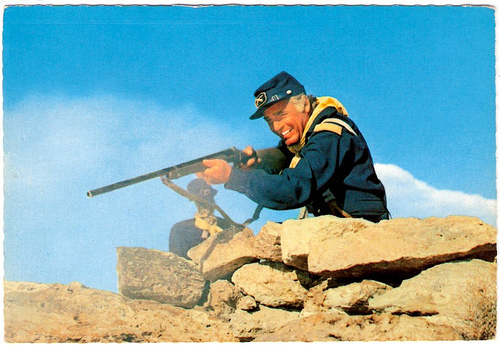
German postcard, no. 32 of 64. Photo: Constantin. Still from Der Letzte Mohikaner/The Last Tomahawk (1965).
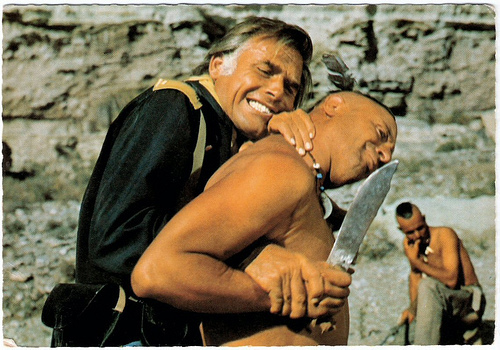
German postcard, no. 20 of 64. Photo: Constantin. Still from Der Letzte Mohikaner/The Last Tomahawk (1965) with Ricardo Rodriguez .
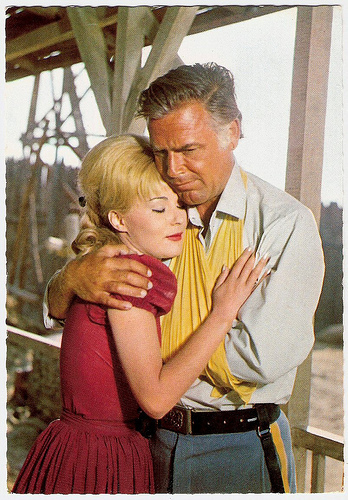
German postcard, no. 44 of 64. Photo: Constantin. Still from Der Letzte Mohikaner/The Last Tomahawk (1965) with Marie France.
A Mountain of Debt
Joachim Fuchsberger appeared also in several other European genre films, such as Horror pictures like The Face of Fu Manchu (Don Sharp, 1965), starring Christopher Lee, and Euro-Westerns like Der Letzte Mohikaner/The Last Tomahawk (Harald Reinl, 1965) based on the James Fenimore Cooper novel The Last of the Mohicans.
In the English-speaking world, he is sometimes credited as Akim Berg or Berger. From time to time, he has appeared in international productions which gained distribution beyond Germany, notably the drama Io la conoscevo bene/I Knew Her Well (Antonio Pietrangeli, 1965) featuring Stefania Sandrelli, and the warfilm Himmelfahrtskommando El Alamein/Commandos (Armando Crispino, 1968), starring American leading man Lee Van Cleef.
In the late 1960s Fuchsberger co-founded a real estate company that went bankrupt in a short time. At 42, he had lost his entire fortune, had to sell his villa and sat on a mountain of debt. With the help of his wife, former actress Gundula Korte, good friends and tireless work, he managed to discharge the debt and to start a new existence.
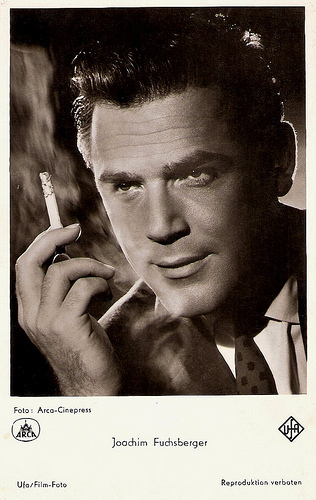
German postcard by Univerum-Film Aktiengesellschaft (Ufa), Berlin-Tempelhof, no. FK 4056. Retail price: 25 Pfg. Photo: Arca-Cinepress. Publicity still for Liebe kann wie Gift sein/Love can be like poison (Veit Harlan, 1958).
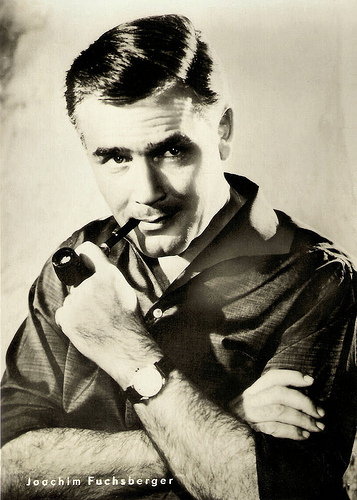
East-German postcard by VEB Progress Film-Vertrieb, Berlin, no. 166/70, 1970
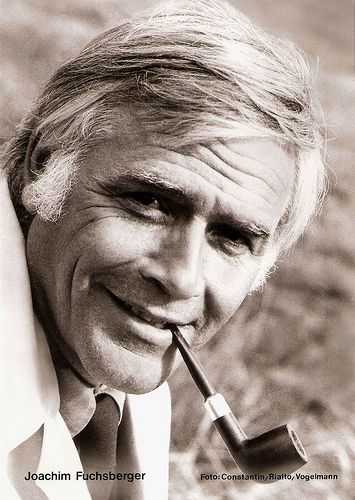
German postcard by Franz Josef Rüdel, Filmpostkartenverlag, Hamburg. Photo: Constantin, Rialto, Vogelmann. Publicity still for Das Geheimnis der grünen Stecknadel/Who Killed Solange? (Massimo Dallamano, 1972).
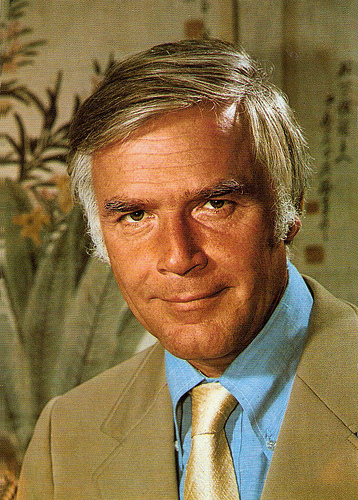
German postcard by Franz Josef Rüdel, Filmpostkartenverlag, Hamburg. Photo: Studio Karl Bayer, Garmisch.
Unplanned Adventure
When the quality of the films of the Edgar Wallace series dropped significantly at the beginning of the 1970s, Joachim Fuchsberger starred in comedies like Das fliegende Klassenzimmer/The Flying Classroom (Werner Jacobs, 1973), based on Erich Kästner's novel, before putting his acting career into hiatus.
In 1972 he published his first book Unplanned Adventure, and in the same year he was the stadium announcer at the 1972 Summer Olympics in Munich. During the closing ceremony, it was suspected that a hijacked passenger aircraft was on its way to the stadium. Fuchsberger, fearing a panic, decided against evacuation. This decision was vindicated when the original suspicion turned out to have been false.
From 1973 on, Fuchsberger exclusively worked as a TV quiz show and talk show host. Only in the late 1990s he started to reappear in television films.
He married twice: from 1951 till 1953 he was married to Schlager singer Gitta Lind. Since 1954 he has been married to Gundula Korte. Their son, Thomas (1957-2010), was a composer.
In 2004 Joachim Fuchsberger rejected an offer to make a cameo appearance on Der Wixxer/The Trixxer (Tobi Baumann, 2004), considering it a bad parody on his own 1960s Edgar Wallace films. After he received a DVD of the film, he saw and liked the film and agreed to play Lord Dickham in its sequel Neues vom Wixxer/The Wexxer (Cyrill Boss, Philipp Stennert, 2007). It was the first theatrical film he made within 34 years.
Fuchsberger lived in Munich, Germany, but also some months of the year near Hobart in Tasmania, Australia. He produced the film series Terra Australis (1988-2003) about his ‘second home country’ and was awarded Honorary Ambassador of Tourism by Tasmania`s Prime Minister in 1999. In 2005, he also was awarded the Bavarian Television Prize for his life's work.
Joachim Fuchsberger died of organ failure at his German home in Grünwald near Munich.
Trailer of Der Frosch mit der Maske/Face of the Frog (1959). Source: R6dw6c (YouTube).
German trailer of The Face of Fu Manchu (1965). Source: tornhill1 (YouTube).
Trailer of Neues vom Wixxer/The Wexxer (2007). Source: PhilDecker07 (YouTube).
Sources: Stephanie D'heil (Steffi-line) (German), Filmportal.de, Hal Erickson (All Movie Guide), Wikipedia, Laif, and .

German postcard by Ufa, Berlin-Tempelhof, no. FK 3981. Photo: Lars Looschen / Ufa.

German postcard, no. 10 of 64. Photo: Constantin. Still from Der Letzte Mohikaner/The Last Tomahawk (1965, Harald Reinl).
Blacky
Joachim ‘Blacky’ Fuchsberger was born in 1927 in Zuffenhausen, today a district of Stuttgart, Germany. He went to secondary school in Heidelberg but was then drafted for the Reich Labour Service and became a parachutist at the Eastern front at the end of the war.
After British war captivity, In 1946 he worked as a coal miner for the British in Recklinghausen. His nickname Blacky, which has been incessantly used by the media, hails from that time. Fuchsberger worked in several jobs as mechanic and conferencier.
In 1950 he began his career in the media, first as a radio announcer at the Bayerischen Rundfunk (Bavarian radio) it kicked off of an unexpected career. From 1953 on, he appeared in several supporting roles in films like Geh mach dein Fensterl auf/Go Open Your Window (Anton Kutter, 1953).
Fuchsberger had his breakthrough in the 08/15 trilogy (Paul May, 1954-1955) based on Hans Hellmut Kirst's novels. His part as Wehrmacht private Asch was followed by several other parts in war films, including U47 - Kapitänleutnant Prien/U-47 Lt. Commander Prien (Harald Reinl, 1958).
Fuchsberger also often appeared as the young lover. The attractive actor did many women's hearts beat faster in light entertainment films like Symphonie in Gold/Symphony in Gold (Franz Antel, 1956), Die Zwillinge vom Zillertal/The twins from the Zillertal (Harald Reinl, 1957) with Isa and Jutta Günther, and Mein Schatz ist aus Tirol/My treasure is from Tirol (Hans Quest, 1958) with Marianne Hold .
In 1959 he starred in Der Frosch mit der Maske/Face of the Frog (Harald Reinl, 1959), playing amateur detective Richard Gordon. More than 3.2 million visitors saw the thriller based on a novel by Edgar Wallace, in the cinema.
This surprising success laid the foundation for 12 other film adaptations of Edgar Wallace mysteries, including Die toten Augen von London/Dead Eyes of London (Alfred Vohrer, 1962) with Karin Baal , Das Gasthaus an der Themse/The Inn on the River (Alfred Vohrer, 1962) with Klaus Kinski , and Der Hexer/The Wizard (Alfred Vohrer, 1964) with Sophie Hardy .

German postcard, no. 32 of 64. Photo: Constantin. Still from Der Letzte Mohikaner/The Last Tomahawk (1965).

German postcard, no. 20 of 64. Photo: Constantin. Still from Der Letzte Mohikaner/The Last Tomahawk (1965) with Ricardo Rodriguez .

German postcard, no. 44 of 64. Photo: Constantin. Still from Der Letzte Mohikaner/The Last Tomahawk (1965) with Marie France.
A Mountain of Debt
Joachim Fuchsberger appeared also in several other European genre films, such as Horror pictures like The Face of Fu Manchu (Don Sharp, 1965), starring Christopher Lee, and Euro-Westerns like Der Letzte Mohikaner/The Last Tomahawk (Harald Reinl, 1965) based on the James Fenimore Cooper novel The Last of the Mohicans.
In the English-speaking world, he is sometimes credited as Akim Berg or Berger. From time to time, he has appeared in international productions which gained distribution beyond Germany, notably the drama Io la conoscevo bene/I Knew Her Well (Antonio Pietrangeli, 1965) featuring Stefania Sandrelli, and the warfilm Himmelfahrtskommando El Alamein/Commandos (Armando Crispino, 1968), starring American leading man Lee Van Cleef.
In the late 1960s Fuchsberger co-founded a real estate company that went bankrupt in a short time. At 42, he had lost his entire fortune, had to sell his villa and sat on a mountain of debt. With the help of his wife, former actress Gundula Korte, good friends and tireless work, he managed to discharge the debt and to start a new existence.

German postcard by Univerum-Film Aktiengesellschaft (Ufa), Berlin-Tempelhof, no. FK 4056. Retail price: 25 Pfg. Photo: Arca-Cinepress. Publicity still for Liebe kann wie Gift sein/Love can be like poison (Veit Harlan, 1958).

East-German postcard by VEB Progress Film-Vertrieb, Berlin, no. 166/70, 1970

German postcard by Franz Josef Rüdel, Filmpostkartenverlag, Hamburg. Photo: Constantin, Rialto, Vogelmann. Publicity still for Das Geheimnis der grünen Stecknadel/Who Killed Solange? (Massimo Dallamano, 1972).

German postcard by Franz Josef Rüdel, Filmpostkartenverlag, Hamburg. Photo: Studio Karl Bayer, Garmisch.
Unplanned Adventure
When the quality of the films of the Edgar Wallace series dropped significantly at the beginning of the 1970s, Joachim Fuchsberger starred in comedies like Das fliegende Klassenzimmer/The Flying Classroom (Werner Jacobs, 1973), based on Erich Kästner's novel, before putting his acting career into hiatus.
In 1972 he published his first book Unplanned Adventure, and in the same year he was the stadium announcer at the 1972 Summer Olympics in Munich. During the closing ceremony, it was suspected that a hijacked passenger aircraft was on its way to the stadium. Fuchsberger, fearing a panic, decided against evacuation. This decision was vindicated when the original suspicion turned out to have been false.
From 1973 on, Fuchsberger exclusively worked as a TV quiz show and talk show host. Only in the late 1990s he started to reappear in television films.
He married twice: from 1951 till 1953 he was married to Schlager singer Gitta Lind. Since 1954 he has been married to Gundula Korte. Their son, Thomas (1957-2010), was a composer.
In 2004 Joachim Fuchsberger rejected an offer to make a cameo appearance on Der Wixxer/The Trixxer (Tobi Baumann, 2004), considering it a bad parody on his own 1960s Edgar Wallace films. After he received a DVD of the film, he saw and liked the film and agreed to play Lord Dickham in its sequel Neues vom Wixxer/The Wexxer (Cyrill Boss, Philipp Stennert, 2007). It was the first theatrical film he made within 34 years.
Fuchsberger lived in Munich, Germany, but also some months of the year near Hobart in Tasmania, Australia. He produced the film series Terra Australis (1988-2003) about his ‘second home country’ and was awarded Honorary Ambassador of Tourism by Tasmania`s Prime Minister in 1999. In 2005, he also was awarded the Bavarian Television Prize for his life's work.
Joachim Fuchsberger died of organ failure at his German home in Grünwald near Munich.
Trailer of Der Frosch mit der Maske/Face of the Frog (1959). Source: R6dw6c (YouTube).
German trailer of The Face of Fu Manchu (1965). Source: tornhill1 (YouTube).
Trailer of Neues vom Wixxer/The Wexxer (2007). Source: PhilDecker07 (YouTube).
Sources: Stephanie D'heil (Steffi-line) (German), Filmportal.de, Hal Erickson (All Movie Guide), Wikipedia, Laif, and .
Published on September 11, 2014 10:18
September 10, 2014
Micheline Presle
Chic and elegant Micheline Presle (1922) gained world-wide attention for Le diable au corps/Devil in the Flesh (Claude Autant-Lara, 1947). She played a Red Cross nurse who has an adulterous love affair with Gérard Philippe during the First World War. Over her long career the French actress has made more than one hundred and fifty films
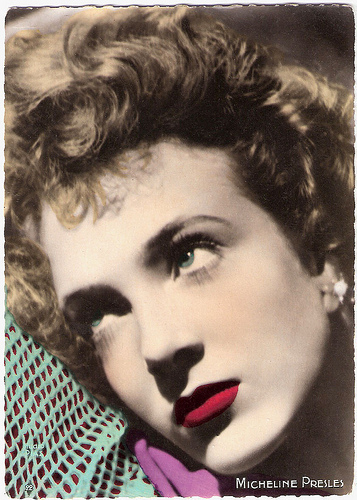
French postcard by Editions P.I., Paris. no. 22. Photo: Studio Piaz.
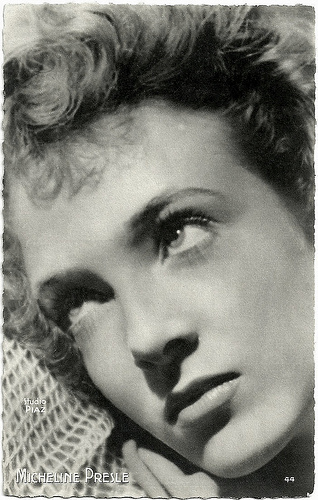
French postcard by Editions O.P., Paris. no. 44. Photo: Studio Piaz.
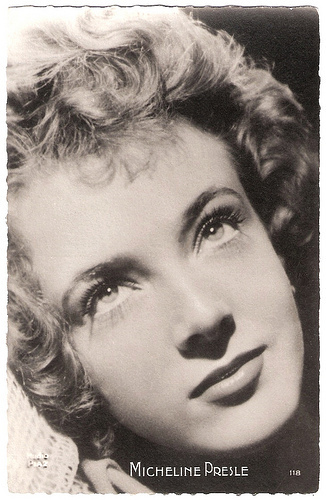
French postcard by Editions O.P., Paris. no. 118. Photo: Studio Piaz.
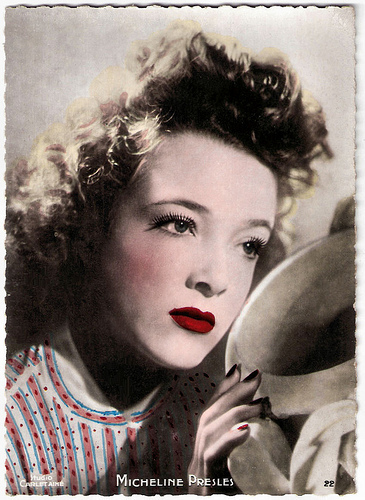
French postcard by Editions P.I., Paris. no. 22. Photo: Studio Carlet Ainé.
Most Promising Actress
Micheline Presle (sometimes Presles or Prelle) was born as Micheline Nicole Julia Émilienne Chassagne in Paris in 1922. She was the daughter of a businessman and took acting classes as a teen.
Her film debut was La Fessée/The Buttock (Pierre Caron, 1937) with Albert Préjean . In 1938 she was awarded with the Prix Suzanne Bianchetti for the most promising actress.
She took the name of Presle after her character's name Jacqueline Presle in Jeune fille en détresse/Girls in Distress (Georg Wilhelm Pabst, 1939).
In the 1930s and the war years Presle often played the lively young and naive girl. Examples are La nuit fantastique/Fantastic Night (Marcel L'Herbier, 1942) and Falbalas/Paris Frills (Jacques Becker, 1944) with Raymond Rouleau.
Presle became a 'vedette' of the French cinema. After the war she played more serious roles as the streetwise young woman, such as the prostitute in Boule de suif/Angel and Sinner (Christian-Jaque, 1946), the adultress in Le diable au corps/Devil in the Flesh (Claude Autant-Lara, 1947), and the ethereal woman coming back from the dead in Les jeux sont faits/Second Chance (Jean Delannoy, 1947).
At the same time she also played the female lead of Helene/Jone in the major Franco-Italian epic Gli ultimi giorni di Pompei/Sins of Pompei (1950) by Paolo Moffa and Marcel L'Herbier, in whose films she was often performing during the 1940s.
At the summit of her French career, Presle went to the US. She was offered a contract by 20th Century Fox and she worked in Hollywood under the name Prelle. She was first cast in Under my skin (Jean Negulesco, 1950) with John Garfield, and then in American Guerrilla in the Philipines (Fritz Lang, 1950) with Tyrone Power.
She was married to actor-turned-producer William Marshall (1950-54), who directed her in The Adventures of Captain Fabian (William Marshall, 1951), opposite Errol Flynn. The film flopped, Presle disliked Hollywood, divorced Marshall, and returned to France.
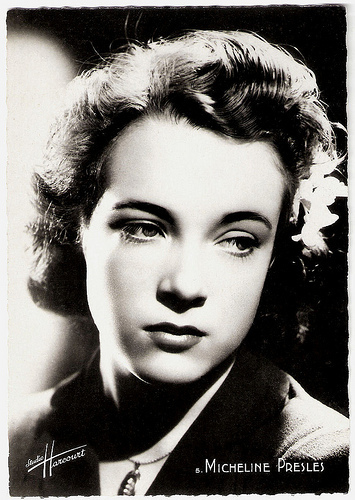
French postcard by SERP, Paris, no. 5. Photo: Studio Harcourt.
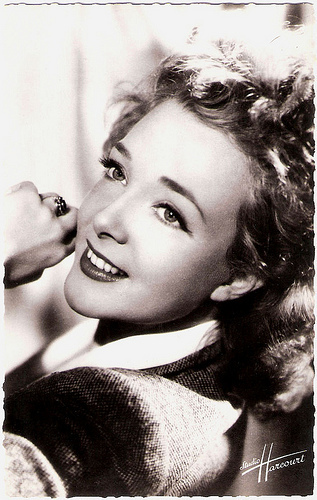
French postcard by Edition du Globe (EDUG), Paris, no. 163. Photo: Studio Harcourt.
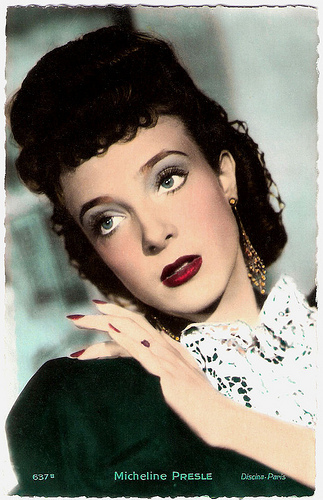
French postcard by Editions Chantal, Rueil, no. 637B. Photo: Discina, Paris.
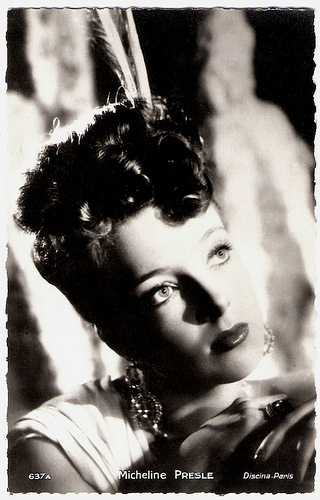
French postcard by Editions Chantal, Rueil, no. 637A. Photo: Discina, Paris.
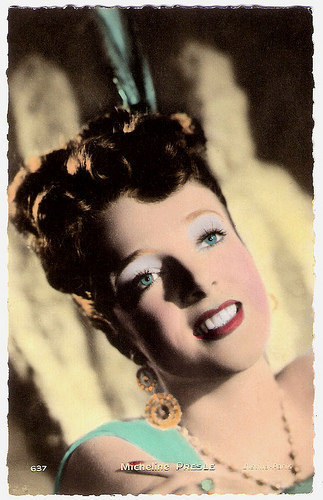
French postcard by Collection Chantal, Paris. no. 637. Photo: Discina, Paris.
Blind Date
Back in France, Micheline Presle played in many films, such as Si Versailles m'était conté/Royal Affairs in Versailles (Sacha Guitry, 1953), Napoléon (Sacha Guitry, 1955), La mariée est trop belle/Her Bridal Night (Pierre Gaspard-Huit, 1956) opposite young Brigitte Bardot , and Christine (Pierre Gaspard-Huit, 1958) with Alain Delon and Romy Schneider .
Presle also performed in Italy in Casa Ricordi/House Ricordi (Carmine Gallone, 1954), Beatrice Cenci/Castle of the Banned Lovers (Riccardo Freda, 1956) and she had a smaller part in Villa Borghese/It Happened in the Park (Gianni Franciolini, Vittorio de Sica, 1953).
In 1959 she played opposite Hardy Kruger in Blind Date (Joseph Losey, 1959) and in 1962 Presle returned to Hollywood to play in the Bobby Darin and Sandra Dee vehicle If a Man Answers (Henry Levin, 1962), and subsequently in The Prize (Mark Robson, 1963) with Paul Newman.
During the 1960s she played in such popular films as Philippe de Broca's Le roi de coeur/The King of Hearts (1965), but also in the art films L'Assassino/The Assassin (Elio Petri, 1961), La Religieuse/The Nun (Jacques Rivette, 1965), Peau d'ane (Jacques Demy, 1970), I Want to Go Home (Alain Resnais, 1989), and Mignon è partita/Mignon Has Come to Stay (Francesca Archibugi, 1989).
From the early 1960s on, Presle also played in several French TV series, such as the long running comedy Les saintes chéries (1965-1970). She has appeared frequently on the stage as well.
Since the 1990s Presle has performed regularly in films. She was very visible in the films of her daughter, Tonie Marshall, as in Pas très catholique/Something Fishy (Tonie Marshall, 1994) and France boutique (Tonie Marshall, 2003).
Recently, Micheline Presle was seen in Thelma, Louise et Chantal (Benoît Pétré, 2010) starring Jane Birkin , and in the short family drama Je montrerai mes seins/I show my tits (Eduardo Sosa Soria, 2013).
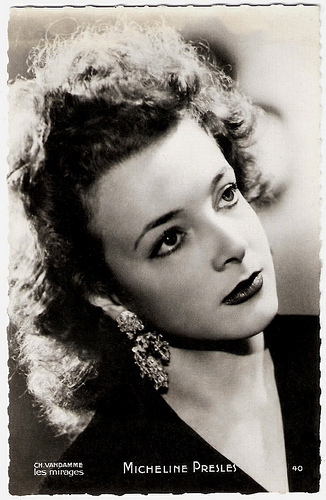
French postcard by Editions P.I., Paris. no. 40. Photo: Charles Vandamme, Les Mirages.
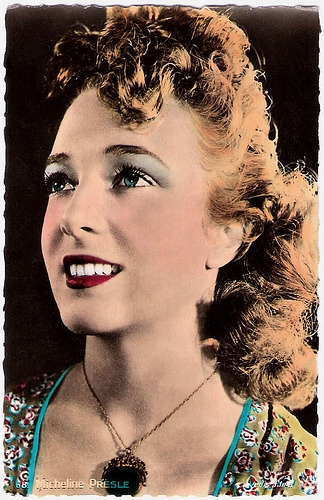
French postcard by Edit. Chantal, Rueil. no. 68. Photo: Védis Films.
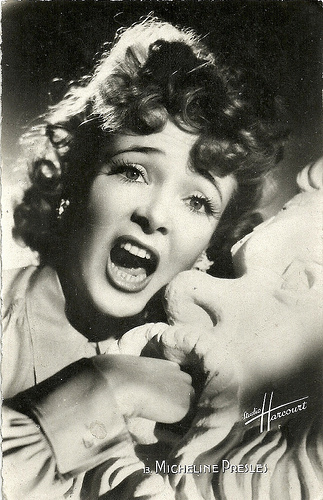
French postcard, no. 13. Photo: Studio Harcourt.
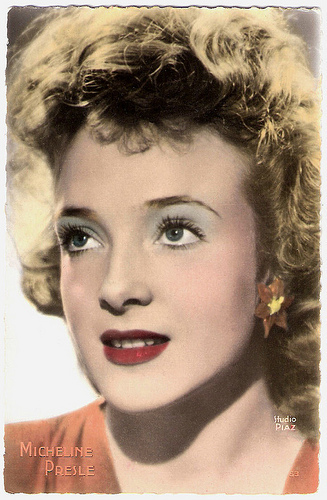
French postcard by Edit. O.P., Paris. no. 53. Photo: Studio Piaz.
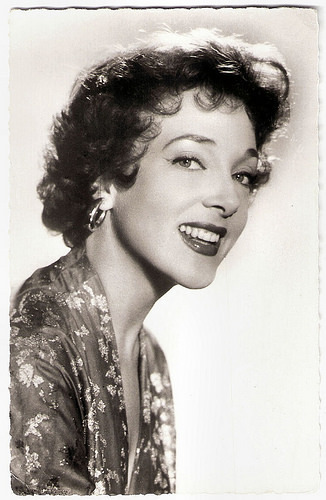
French postcard by Editions du Globe, Paris. no. 619. Photo: Sam Lévin , Paris.
Sources: (IMDb), Allociné, Wikipedia, and .

French postcard by Editions P.I., Paris. no. 22. Photo: Studio Piaz.

French postcard by Editions O.P., Paris. no. 44. Photo: Studio Piaz.

French postcard by Editions O.P., Paris. no. 118. Photo: Studio Piaz.

French postcard by Editions P.I., Paris. no. 22. Photo: Studio Carlet Ainé.
Most Promising Actress
Micheline Presle (sometimes Presles or Prelle) was born as Micheline Nicole Julia Émilienne Chassagne in Paris in 1922. She was the daughter of a businessman and took acting classes as a teen.
Her film debut was La Fessée/The Buttock (Pierre Caron, 1937) with Albert Préjean . In 1938 she was awarded with the Prix Suzanne Bianchetti for the most promising actress.
She took the name of Presle after her character's name Jacqueline Presle in Jeune fille en détresse/Girls in Distress (Georg Wilhelm Pabst, 1939).
In the 1930s and the war years Presle often played the lively young and naive girl. Examples are La nuit fantastique/Fantastic Night (Marcel L'Herbier, 1942) and Falbalas/Paris Frills (Jacques Becker, 1944) with Raymond Rouleau.
Presle became a 'vedette' of the French cinema. After the war she played more serious roles as the streetwise young woman, such as the prostitute in Boule de suif/Angel and Sinner (Christian-Jaque, 1946), the adultress in Le diable au corps/Devil in the Flesh (Claude Autant-Lara, 1947), and the ethereal woman coming back from the dead in Les jeux sont faits/Second Chance (Jean Delannoy, 1947).
At the same time she also played the female lead of Helene/Jone in the major Franco-Italian epic Gli ultimi giorni di Pompei/Sins of Pompei (1950) by Paolo Moffa and Marcel L'Herbier, in whose films she was often performing during the 1940s.
At the summit of her French career, Presle went to the US. She was offered a contract by 20th Century Fox and she worked in Hollywood under the name Prelle. She was first cast in Under my skin (Jean Negulesco, 1950) with John Garfield, and then in American Guerrilla in the Philipines (Fritz Lang, 1950) with Tyrone Power.
She was married to actor-turned-producer William Marshall (1950-54), who directed her in The Adventures of Captain Fabian (William Marshall, 1951), opposite Errol Flynn. The film flopped, Presle disliked Hollywood, divorced Marshall, and returned to France.

French postcard by SERP, Paris, no. 5. Photo: Studio Harcourt.

French postcard by Edition du Globe (EDUG), Paris, no. 163. Photo: Studio Harcourt.

French postcard by Editions Chantal, Rueil, no. 637B. Photo: Discina, Paris.

French postcard by Editions Chantal, Rueil, no. 637A. Photo: Discina, Paris.

French postcard by Collection Chantal, Paris. no. 637. Photo: Discina, Paris.
Blind Date
Back in France, Micheline Presle played in many films, such as Si Versailles m'était conté/Royal Affairs in Versailles (Sacha Guitry, 1953), Napoléon (Sacha Guitry, 1955), La mariée est trop belle/Her Bridal Night (Pierre Gaspard-Huit, 1956) opposite young Brigitte Bardot , and Christine (Pierre Gaspard-Huit, 1958) with Alain Delon and Romy Schneider .
Presle also performed in Italy in Casa Ricordi/House Ricordi (Carmine Gallone, 1954), Beatrice Cenci/Castle of the Banned Lovers (Riccardo Freda, 1956) and she had a smaller part in Villa Borghese/It Happened in the Park (Gianni Franciolini, Vittorio de Sica, 1953).
In 1959 she played opposite Hardy Kruger in Blind Date (Joseph Losey, 1959) and in 1962 Presle returned to Hollywood to play in the Bobby Darin and Sandra Dee vehicle If a Man Answers (Henry Levin, 1962), and subsequently in The Prize (Mark Robson, 1963) with Paul Newman.
During the 1960s she played in such popular films as Philippe de Broca's Le roi de coeur/The King of Hearts (1965), but also in the art films L'Assassino/The Assassin (Elio Petri, 1961), La Religieuse/The Nun (Jacques Rivette, 1965), Peau d'ane (Jacques Demy, 1970), I Want to Go Home (Alain Resnais, 1989), and Mignon è partita/Mignon Has Come to Stay (Francesca Archibugi, 1989).
From the early 1960s on, Presle also played in several French TV series, such as the long running comedy Les saintes chéries (1965-1970). She has appeared frequently on the stage as well.
Since the 1990s Presle has performed regularly in films. She was very visible in the films of her daughter, Tonie Marshall, as in Pas très catholique/Something Fishy (Tonie Marshall, 1994) and France boutique (Tonie Marshall, 2003).
Recently, Micheline Presle was seen in Thelma, Louise et Chantal (Benoît Pétré, 2010) starring Jane Birkin , and in the short family drama Je montrerai mes seins/I show my tits (Eduardo Sosa Soria, 2013).

French postcard by Editions P.I., Paris. no. 40. Photo: Charles Vandamme, Les Mirages.

French postcard by Edit. Chantal, Rueil. no. 68. Photo: Védis Films.

French postcard, no. 13. Photo: Studio Harcourt.

French postcard by Edit. O.P., Paris. no. 53. Photo: Studio Piaz.

French postcard by Editions du Globe, Paris. no. 619. Photo: Sam Lévin , Paris.
Sources: (IMDb), Allociné, Wikipedia, and .
Published on September 10, 2014 23:00
September 9, 2014
Bella Darvi
Beautiful Bella Darvi (1926–1971) was a French and American actress of Polish-Jewish origins. She is better known for her jet-set affairs than for her films. During the early 1950s he was the mistress of Hollywood mogul Darryl F. Zanuck. This connection both created and finished her short Hollywood career. Later she appeared in European films, but made more headlines with her gambling and suicide attempts.
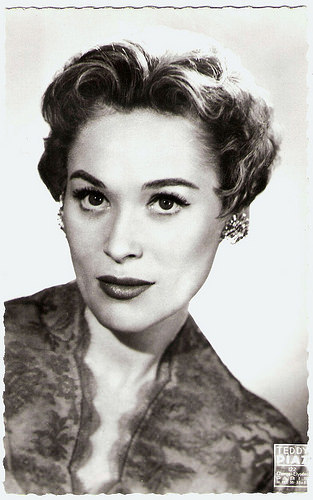
French postcard by Editions P.I., Paris, no. 820. Photo: Teddy Piaz, Paris.
The French doll with the impact of TNT
Bella Darvi was born Bayla Wegier in Sosnowiec, Poland in 1926 (some sources say 1928). Her parents were Chaym Wegier, a baker, and his wife, Chaya (née Zygelbaum). She had three brothers, Robert, Jacques, and Jean-Isidore, and a sister, Sura.
A year after her birth the Wegier family moved to France. There she had a happy childhood until the French occupation by the Germans. During World War II, Bella was jailed in 1943. After her liberation she went to her family in Perigueux, but she found their house burned down. Happily most of her family had escaped, only her brother Robert died in a concentration camp.
She went to work as a nurse. In 1950, she married a rich businessman, Alban Cavalade and travelled with him to Monaco. They frequented the gambling spots on the Riviera, in Deauville and Biarritz and she had a highly active social life, which revolved around automobile and fashion shows in Cannes, Deauville, and Enghien.
At a Paris fashion show in 1951, she was spotted by Virginia Fox, the wife of Hollywood mogul Darryl F. Zanuck. Virginia introduced her to Darryl, who invited her to come to Hollywood. In 1952, she divorced Cavalade, and moved into Zanuck's beach house at Santa Monica.
In 1953, she did a screen-test with Zanuck in CinemaScope and signed a contract at 20th Century Fox. Zanuck changed her name to Bella Darvi, Darvi a combination of the first names of Zanuck and his wife. The press heralded the beautiful Brunette with her angular features as the 'French doll with the impact of TNT'. "She's got zip, zoom, and zowie and in parlez-vous she's ravissante, chi-chi, and trés élégante."
She made her feature debut as Richard Widmark's love interest in the Cold War drama Hell and High Water (Sam Fuller, 1954). The film was made to showcase CinemaScope being used in the confined sets of a submarine. Hell and High Water did excellent box office in the United States and abroad, particularly in Germany. Darvi won a Golden Globe for her role.
She is probably best known for her next role, the seductive Babylonian courtesan Nefer, in The Egyptian (Michael Curtiz, 1954). Marilyn Monroe coveted the role of Nefer, only to discover that it was earmarked for Darvi. Next she was the love interest of Kirk Douglas in The Racers (Henry Hathaway, 1955).
Eventually, Bella had become Zanuck's mistress, although she reportedly dated other men including Robert Stack and Brad Dexter. When Virginia Fox was told about the affair by her daughter Susan, she threw Darvi out of the house. Darvi decided that her Hollywood career was over and bought a one-way-ticket to France.
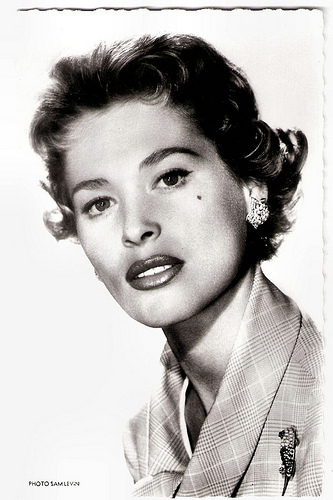
French postcard by Editions du Globe, Paris, no. 605. Photo: Sam Lévin , Paris.
Gambling and drinking habits
Darryl Zanuck left his wife for Bella Darvi, and he withdrew from the studio. Zanuck followed Darvi to France where he concentrated on independent producing.
Darvi continued her film career in the French cinema. She co-starred with Eddie Constantine in the French-Italian crime film Je suis un sentimental/Headlines of Destruction (John Berry, 1955).
In 1955, Zanuck left Darvi when he discovered that she was bisexual, according to Wikipedia . Darvi later publicly dated women, as well as extremely wealthy men. Her love life was always juicy fodder for the tabloids, but she was unable to establish a permanent relationship or to curb her gambling and drinking habits. At one point her gambling was so out of control that she was forced to pawn her jewels, furs, clothing, furniture and two poodles to make ends meet.
Her European films were mostly mediocre. They include Raffles sur la ville/Sinners of Paris (Pierre Chenal, 1957) with Charles Vanel , Le gorille vous salue bien/The Mask of the Gorilla (Bernard Borderie, 1958) starring Lino Ventura , and Le pain des Jules/Jules' Breadwinner (Jacques Séverac, 1960) with Henri Vilbert.
She also played in Italian director Damiano Damiani’s feature film debut, the crime-drama Il rossetto/Lipstick (Damiano Damiani, 1960) with Pierre Brice .
In 1960, Darvi married Claude Rouas, a restaurant waiter, in Las Vegas. The marriage was annulled less than a year later.
After several failed suicide attempts, she was put in a clinic on the Riviera in 1968. Zanuck was still paying off her debts when she was ill and financially ruined.
Her final films were the comedy Le bourgeois gentil mec/The bourgeois nice guy (Raoul André, 1969) starring Jean Lefebvre , and the erotic comedy Les Petites Filles modèles/Good Little Girls (Jean-Claude Roy, 1971), a pastiche of Countess de Ségur's novel Les Petites Filles modèles.
In 1971, Bella Darvi took her life in a small apartment in Monte Carlo by opening the gas jets on her stove. It happened on the same day that Pier Angeli also took her own life. According to IMDb , Darryl F. Zanuck had ignored her final plea. Darvi’s body was not discovered for ten days. She was only 44.
At IMDb , Gary Brumburgh writes that her abilities were limited: "Not only was she hampered by an ever-so-slight crossed-eyed appearance, she had a trace of a lisp which, combined with a foreign accent, made her speech appear slurred and difficult to understand."
In recent years however, Bella Darvi was also praised by some critics, including Camille Paglia, who described her performance in The Egyptian (1954) as ‘hypnotic’.
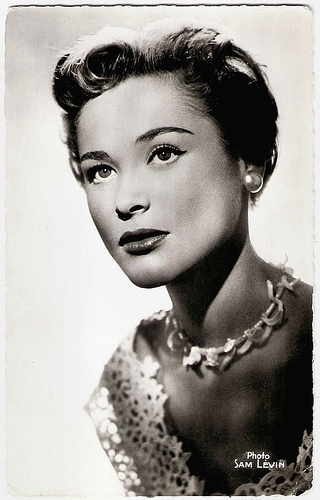
French postcard by Editions du Globe, Paris, no. 443. Photo: Sam Lévin , Paris.
Source: Philippe Pelletier (Les Gens du Cinéma) (French), (IMDb), Glamour Girls of the Silver Screen, Find A Grave, Wikipedia and .

French postcard by Editions P.I., Paris, no. 820. Photo: Teddy Piaz, Paris.
The French doll with the impact of TNT
Bella Darvi was born Bayla Wegier in Sosnowiec, Poland in 1926 (some sources say 1928). Her parents were Chaym Wegier, a baker, and his wife, Chaya (née Zygelbaum). She had three brothers, Robert, Jacques, and Jean-Isidore, and a sister, Sura.
A year after her birth the Wegier family moved to France. There she had a happy childhood until the French occupation by the Germans. During World War II, Bella was jailed in 1943. After her liberation she went to her family in Perigueux, but she found their house burned down. Happily most of her family had escaped, only her brother Robert died in a concentration camp.
She went to work as a nurse. In 1950, she married a rich businessman, Alban Cavalade and travelled with him to Monaco. They frequented the gambling spots on the Riviera, in Deauville and Biarritz and she had a highly active social life, which revolved around automobile and fashion shows in Cannes, Deauville, and Enghien.
At a Paris fashion show in 1951, she was spotted by Virginia Fox, the wife of Hollywood mogul Darryl F. Zanuck. Virginia introduced her to Darryl, who invited her to come to Hollywood. In 1952, she divorced Cavalade, and moved into Zanuck's beach house at Santa Monica.
In 1953, she did a screen-test with Zanuck in CinemaScope and signed a contract at 20th Century Fox. Zanuck changed her name to Bella Darvi, Darvi a combination of the first names of Zanuck and his wife. The press heralded the beautiful Brunette with her angular features as the 'French doll with the impact of TNT'. "She's got zip, zoom, and zowie and in parlez-vous she's ravissante, chi-chi, and trés élégante."
She made her feature debut as Richard Widmark's love interest in the Cold War drama Hell and High Water (Sam Fuller, 1954). The film was made to showcase CinemaScope being used in the confined sets of a submarine. Hell and High Water did excellent box office in the United States and abroad, particularly in Germany. Darvi won a Golden Globe for her role.
She is probably best known for her next role, the seductive Babylonian courtesan Nefer, in The Egyptian (Michael Curtiz, 1954). Marilyn Monroe coveted the role of Nefer, only to discover that it was earmarked for Darvi. Next she was the love interest of Kirk Douglas in The Racers (Henry Hathaway, 1955).
Eventually, Bella had become Zanuck's mistress, although she reportedly dated other men including Robert Stack and Brad Dexter. When Virginia Fox was told about the affair by her daughter Susan, she threw Darvi out of the house. Darvi decided that her Hollywood career was over and bought a one-way-ticket to France.

French postcard by Editions du Globe, Paris, no. 605. Photo: Sam Lévin , Paris.
Gambling and drinking habits
Darryl Zanuck left his wife for Bella Darvi, and he withdrew from the studio. Zanuck followed Darvi to France where he concentrated on independent producing.
Darvi continued her film career in the French cinema. She co-starred with Eddie Constantine in the French-Italian crime film Je suis un sentimental/Headlines of Destruction (John Berry, 1955).
In 1955, Zanuck left Darvi when he discovered that she was bisexual, according to Wikipedia . Darvi later publicly dated women, as well as extremely wealthy men. Her love life was always juicy fodder for the tabloids, but she was unable to establish a permanent relationship or to curb her gambling and drinking habits. At one point her gambling was so out of control that she was forced to pawn her jewels, furs, clothing, furniture and two poodles to make ends meet.
Her European films were mostly mediocre. They include Raffles sur la ville/Sinners of Paris (Pierre Chenal, 1957) with Charles Vanel , Le gorille vous salue bien/The Mask of the Gorilla (Bernard Borderie, 1958) starring Lino Ventura , and Le pain des Jules/Jules' Breadwinner (Jacques Séverac, 1960) with Henri Vilbert.
She also played in Italian director Damiano Damiani’s feature film debut, the crime-drama Il rossetto/Lipstick (Damiano Damiani, 1960) with Pierre Brice .
In 1960, Darvi married Claude Rouas, a restaurant waiter, in Las Vegas. The marriage was annulled less than a year later.
After several failed suicide attempts, she was put in a clinic on the Riviera in 1968. Zanuck was still paying off her debts when she was ill and financially ruined.
Her final films were the comedy Le bourgeois gentil mec/The bourgeois nice guy (Raoul André, 1969) starring Jean Lefebvre , and the erotic comedy Les Petites Filles modèles/Good Little Girls (Jean-Claude Roy, 1971), a pastiche of Countess de Ségur's novel Les Petites Filles modèles.
In 1971, Bella Darvi took her life in a small apartment in Monte Carlo by opening the gas jets on her stove. It happened on the same day that Pier Angeli also took her own life. According to IMDb , Darryl F. Zanuck had ignored her final plea. Darvi’s body was not discovered for ten days. She was only 44.
At IMDb , Gary Brumburgh writes that her abilities were limited: "Not only was she hampered by an ever-so-slight crossed-eyed appearance, she had a trace of a lisp which, combined with a foreign accent, made her speech appear slurred and difficult to understand."
In recent years however, Bella Darvi was also praised by some critics, including Camille Paglia, who described her performance in The Egyptian (1954) as ‘hypnotic’.

French postcard by Editions du Globe, Paris, no. 443. Photo: Sam Lévin , Paris.
Source: Philippe Pelletier (Les Gens du Cinéma) (French), (IMDb), Glamour Girls of the Silver Screen, Find A Grave, Wikipedia and .
Published on September 09, 2014 23:00
September 8, 2014
Elma Karlowa
Yugoslav actress Elma Karlowa (1932-1994) was a star of the German popular cinema of the 1950s and early 1960s. After a personal crisis she returned to the screen in more serious films by directors like Rainer Werner Fassbinder.
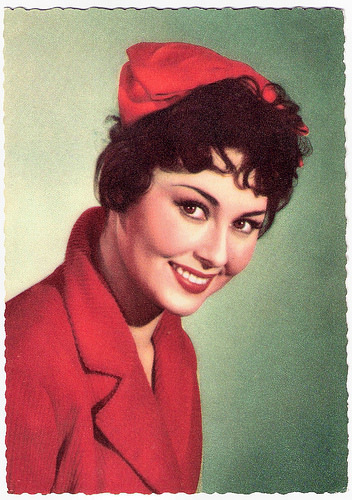
German postcard by Ufa, Berlin-Tempelhof, no. CK 47. Photo: Werler / Prisma-Film.
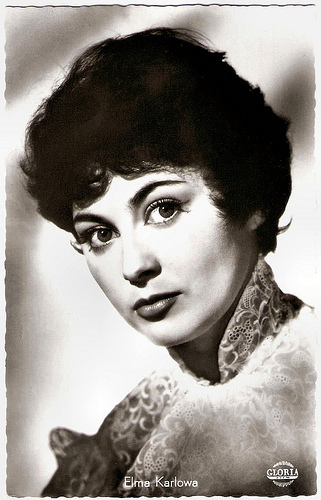
German postcard by Kolibri-Verlag, Berlin-Tempelhof, no. 1645. Photo: Berolina / Herzog-Film / Wesel. Publicity still for Der fröhliche Wanderer/The Happy Wanderer (Hans Quest, 1955).
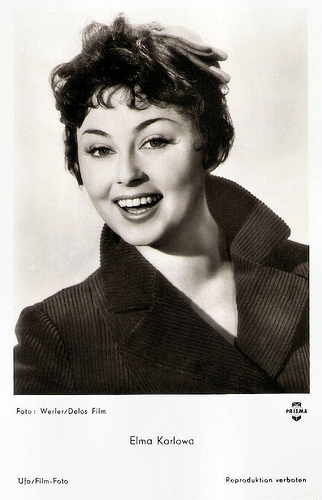
German postcard by Universum-Film Aktiengesellschaft (Ufa), Berlin-Tempelhof, no. FK 3446. Retail price: 25 Pfg. Photo: Werler / Delos Film / Prisma.
Lover or Vamp
Elma Karlowa was born as Selma-Karolina Karlowac in Zagreb, Yugoslavia (now Croatia), in 1932.
She started her acting career in Yugoslavia, and played as Selma Karlovac leading parts in the Yugoslavian films Ciganka/The Gypsy Girl (Vojislav Nanovic, 1953) and the comedy Opstinsko dete/Municipal Child (Mladomir 'Purisa' Djordjevic, 1953).
The postwar German film was often situated in Istria on the Adriatic coast, and so Elma Karlowa was selected for the lead role in the entertainment film Einmal kehr' ich wieder - Dalmatinische Hochzeit/Once I´ll return - Dalmatian Wedding (Géza von Bolváry, 1953) starring Paul Dahlke.
From then on she continued her career in Germany. Her brown eyes and distinctive southern accent predestined her for the roles of lover or vamp in films like Dieses Lied bleibt bei Dir/Cabaret (Willi Forst, 1954) starring Paul Henreid, the film operetta Der Bettelstudent/The Beggar Student (Werner Jacobs, 1956) and in Emmerich Kalman's film biography, Der Czardas-König/The Csardas Princess (Harald Philipp, 1958) starring Gerhard Riedmann.
Karlowa played in the 1950s and early 1960s, mainly in the silly musicals and comedies of that period. She made one serious production in Yugoslavia, the war film Kapetan Lesi/Captain Lechi (Zivorad 'Zika' Mitrovic, 1958).
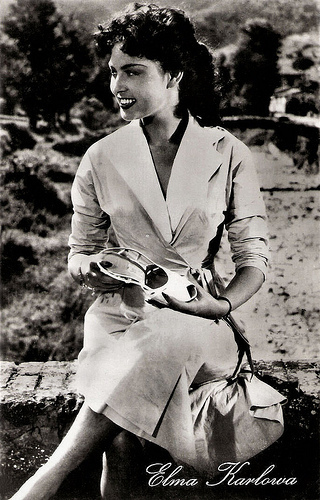
East-German postcard by VEB Progress Filmvertrieb, Berlin, no. 214/57. Photo: Neue Emelka / Willy Zeyn-produktion, no. 277.
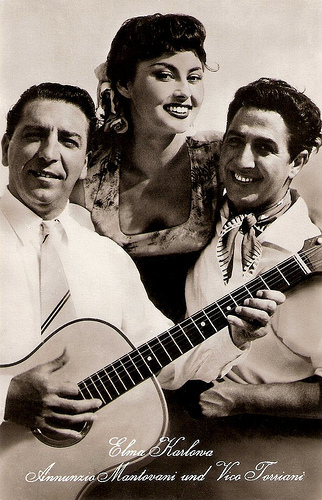
East-German postcard by Progress Vertrieb, Berlin, no. 282, 1957. Photo: Neue Emelka/Willy-Zeyn-Produktion. Publicity still for Gitarren der Liebe/Guitars of Love (Werner Jacobs, 1954) with Vico Torriani and Annunzio Mantovani.
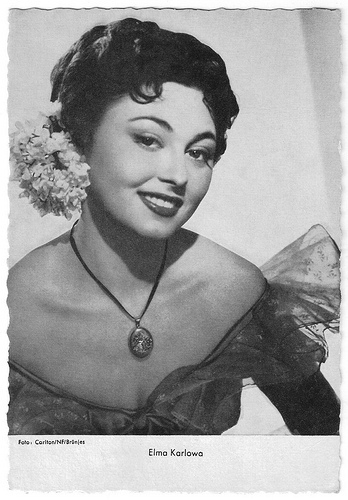
German card by WS-Drück, Wasnne/Eickel. Photo: Carlton-NF-Brùnjes.
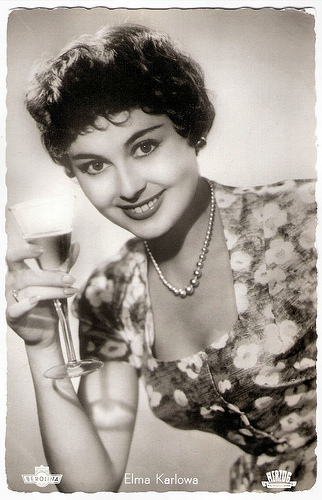
German postcard by Kolibri-Verlag, Berlin-Tempelhof, no. 1624. Photo: Mondial / Gloria-Film / Lilo. Publicity still for Rosenmontag/Rose Monday (Willy Birgel, 1955).
Weight Problems
Toward the end of the post-war boom in film roles, Elma Karlowa received only a few more film offers in Germany. She was struggling with weight problems and psychological difficulties. She fell into a depression, and even tried to kill herself with sleeping pills.
After a period outside of the film business, she played a supporting part in the Vladimir Nabokov adaptation King, Queen, Knave (Jerzy Skolimowsky, 1972) starring Gina Lollobrigida and David Niven .
After a few detours to soft porn like Junge Mädchen mögen's heiß, Hausfrauen noch heißer/Sex Clinic ´74 (Eberhard Schroder, 1973), she received another serious role in Angst essen Seele auf/Ali: Fear Eats the Soul (Rainer Werner Fassbinder, 1974).
She was also seen in supporting parts in Fassbinder´s (TV-)films Welt am Draht/World on a Wire (Rainer Werner Fassbinder, 1973), Martha (Rainer Werner Fassbinder, 1974), Faustrecht der Freiheit/Fox and His Friends (Rainer Werner Fassbinder, 1975), Bolwieser (Rainer Werner Fassbinder, 1977) and Berlin Alexanderplatz (Rainer Werner Fassbinder, 1980).
International productions in which she played were Crime and Passion (Ivan Passer, 1976) starring Omar Sharif, and Fedora (Billy Wilder, 1978) starring William Holden and Hildegard Knef .
She last appeared on TV in the popular Krimi series Tatort (1978-1994).
Elma Karlowa died in 1994 in Munich, Germany.
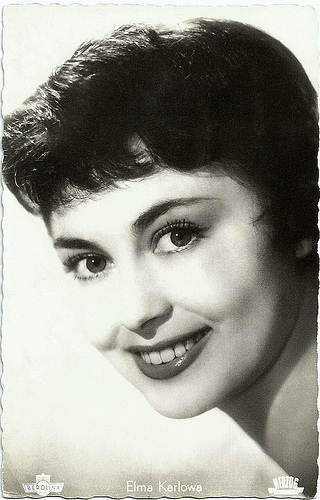
German postcard. Photo: Berolina Film / Herzog.
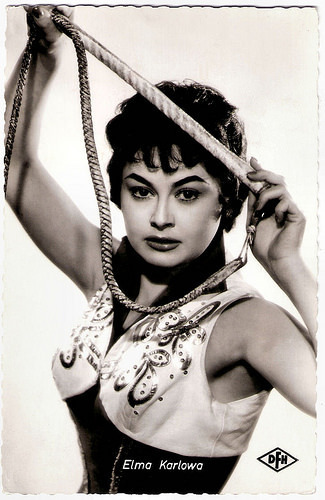
German postcard by Kolibri-Verlag, Minden/Westf., no. 528. Photo: Corona-Film / Deutsche Film Hansa / Lilo. Publicity still for Menschen, Tiere, Sensationen/Rivalen der Manege/Bimbo the Great (Harald Philipp, 1958).
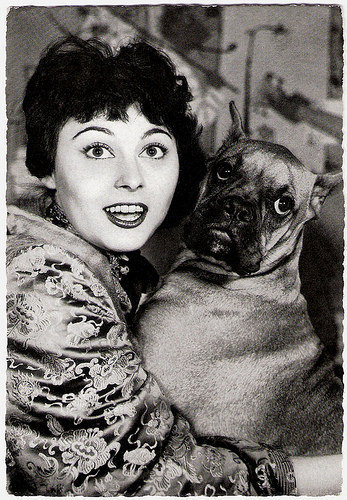
German postcard by WS-Druck, Wanne-Eckel, no. 156. Photo: Theo Huszar.
Elma Karlowa and Waltraut Haas sing Der Mann von dem ich träume in Der Bettelstudent/The Beggar Student (Werner Jacobs, 1956). Source: musipokus (YouTube).
Sources: Stephanie D´heil (Steffi-line), Wikipedia (German) and .

German postcard by Ufa, Berlin-Tempelhof, no. CK 47. Photo: Werler / Prisma-Film.

German postcard by Kolibri-Verlag, Berlin-Tempelhof, no. 1645. Photo: Berolina / Herzog-Film / Wesel. Publicity still for Der fröhliche Wanderer/The Happy Wanderer (Hans Quest, 1955).

German postcard by Universum-Film Aktiengesellschaft (Ufa), Berlin-Tempelhof, no. FK 3446. Retail price: 25 Pfg. Photo: Werler / Delos Film / Prisma.
Lover or Vamp
Elma Karlowa was born as Selma-Karolina Karlowac in Zagreb, Yugoslavia (now Croatia), in 1932.
She started her acting career in Yugoslavia, and played as Selma Karlovac leading parts in the Yugoslavian films Ciganka/The Gypsy Girl (Vojislav Nanovic, 1953) and the comedy Opstinsko dete/Municipal Child (Mladomir 'Purisa' Djordjevic, 1953).
The postwar German film was often situated in Istria on the Adriatic coast, and so Elma Karlowa was selected for the lead role in the entertainment film Einmal kehr' ich wieder - Dalmatinische Hochzeit/Once I´ll return - Dalmatian Wedding (Géza von Bolváry, 1953) starring Paul Dahlke.
From then on she continued her career in Germany. Her brown eyes and distinctive southern accent predestined her for the roles of lover or vamp in films like Dieses Lied bleibt bei Dir/Cabaret (Willi Forst, 1954) starring Paul Henreid, the film operetta Der Bettelstudent/The Beggar Student (Werner Jacobs, 1956) and in Emmerich Kalman's film biography, Der Czardas-König/The Csardas Princess (Harald Philipp, 1958) starring Gerhard Riedmann.
Karlowa played in the 1950s and early 1960s, mainly in the silly musicals and comedies of that period. She made one serious production in Yugoslavia, the war film Kapetan Lesi/Captain Lechi (Zivorad 'Zika' Mitrovic, 1958).

East-German postcard by VEB Progress Filmvertrieb, Berlin, no. 214/57. Photo: Neue Emelka / Willy Zeyn-produktion, no. 277.

East-German postcard by Progress Vertrieb, Berlin, no. 282, 1957. Photo: Neue Emelka/Willy-Zeyn-Produktion. Publicity still for Gitarren der Liebe/Guitars of Love (Werner Jacobs, 1954) with Vico Torriani and Annunzio Mantovani.

German card by WS-Drück, Wasnne/Eickel. Photo: Carlton-NF-Brùnjes.

German postcard by Kolibri-Verlag, Berlin-Tempelhof, no. 1624. Photo: Mondial / Gloria-Film / Lilo. Publicity still for Rosenmontag/Rose Monday (Willy Birgel, 1955).
Weight Problems
Toward the end of the post-war boom in film roles, Elma Karlowa received only a few more film offers in Germany. She was struggling with weight problems and psychological difficulties. She fell into a depression, and even tried to kill herself with sleeping pills.
After a period outside of the film business, she played a supporting part in the Vladimir Nabokov adaptation King, Queen, Knave (Jerzy Skolimowsky, 1972) starring Gina Lollobrigida and David Niven .
After a few detours to soft porn like Junge Mädchen mögen's heiß, Hausfrauen noch heißer/Sex Clinic ´74 (Eberhard Schroder, 1973), she received another serious role in Angst essen Seele auf/Ali: Fear Eats the Soul (Rainer Werner Fassbinder, 1974).
She was also seen in supporting parts in Fassbinder´s (TV-)films Welt am Draht/World on a Wire (Rainer Werner Fassbinder, 1973), Martha (Rainer Werner Fassbinder, 1974), Faustrecht der Freiheit/Fox and His Friends (Rainer Werner Fassbinder, 1975), Bolwieser (Rainer Werner Fassbinder, 1977) and Berlin Alexanderplatz (Rainer Werner Fassbinder, 1980).
International productions in which she played were Crime and Passion (Ivan Passer, 1976) starring Omar Sharif, and Fedora (Billy Wilder, 1978) starring William Holden and Hildegard Knef .
She last appeared on TV in the popular Krimi series Tatort (1978-1994).
Elma Karlowa died in 1994 in Munich, Germany.

German postcard. Photo: Berolina Film / Herzog.

German postcard by Kolibri-Verlag, Minden/Westf., no. 528. Photo: Corona-Film / Deutsche Film Hansa / Lilo. Publicity still for Menschen, Tiere, Sensationen/Rivalen der Manege/Bimbo the Great (Harald Philipp, 1958).

German postcard by WS-Druck, Wanne-Eckel, no. 156. Photo: Theo Huszar.
Elma Karlowa and Waltraut Haas sing Der Mann von dem ich träume in Der Bettelstudent/The Beggar Student (Werner Jacobs, 1956). Source: musipokus (YouTube).
Sources: Stephanie D´heil (Steffi-line), Wikipedia (German) and .
Published on September 08, 2014 23:00
September 7, 2014
Donatas Banionis (1924-2014)
At Thursday 4 September 2014, Iconic Soviet-era actor Donatas Banionis (1924-2014) has died in Vilnius at the age of 90. The Lithuanian actor is best known in the West as Kris Kelvin, the lead role of Andrei Tarkovsky's legendary Science-Fiction film Solyaris/Solaris (1972). In another role he inspired Vladimir Putin to become a KGB spy.
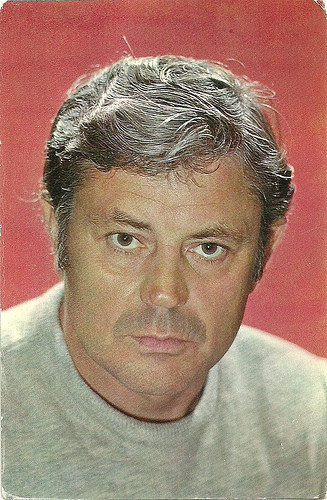
Soviet-Russian postcard.
Russian James Bond
Donatas Banionis was born in Lithuania's central city of Kaunas, in 1924. His mother, Blazhaitite-Banionene Ona, was a homemaker. His father, Juozas Banionis, was a tailor who took part in the Russian Revolution of 1917, was wounded in the Russian Civil War, then became a political prisoner, and briefly emigrated to Brazil during the 1920s. Young Banionis was raised with his elder sister during the years of Lithuanian independence before WWII.
After visiting the Kaunas School of Crafts, Banionis began his acting career at the age of 17 at the Drama Theatre of Panevėžys, where his first teacher was Juozas Miltinis.
In 1959, he started to act in films. He made his film debut in the Lithuanian film Adomas nori buti zmogumi/Adam Wants To Be A Human (Vytautas Zalakevicius, 1959). His performance of the farmer Vaitkus in Niekas nenorėjo mirti/Nobody Wanted to Die (Vytautas Žalakevičius, 1965) won him the award for best actor at the Karlovy Vary film festival. Soon he was a highly requested actor, with many parts in prestigious national and international productions.
He played Ladeinikov, a James Bond-like intelligence agent in in the Soviet spy film Myortvyy sezon/Dead Season (Savva Kulish, 1966). This role reportedly inspired Vladimir Putin in his choice to become a KGB officer. When years later, Banionis met the Russian president at the Kremlin, the actor asked if it was true that his character influenced his choice of profession. Putin laughed and said, “Yes, I suppose you can say that.”
Banionis had a supporting part in Mikhail Kalatozov’s Italo-Russian production Krasnaja palatka/The Red Tent (1969), The film is based on the story of Roald Amundsen's ( Sean Connery ) expedition to rescue Umberto Nobile (Peter Finch) and the other survivors of the crash of the Airship Italia.
He also played the title roles of Francisco Goya of the USSR-GDR coproduction Goya – oder der arge Weg der Erkenntnis/Goya or the Hard Way to Enlightenment (Konrad Wolf, 1971), and Ludwig van Beethoven in the DEFA-production Beethoven - Tage aus einem Leben/Beethoven-Days in a Life (Horst Seemann, 1976).
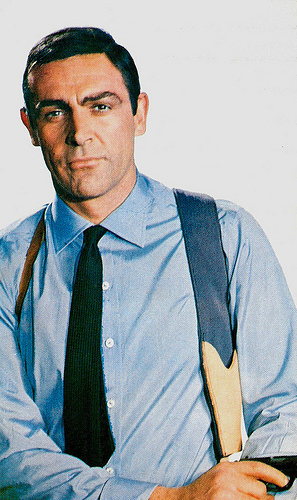
Sean Connery . French postcard by PSG, no. 454, offered by Corvisart, Epinal. Photo: Lynx.
The Planet Solaris
Donatas Banionis played a supporting part in Grigori Kozintsev’s drama Korol Lir/King Lear (1971), based on William Shakespeare's play King Lear. The film featured the Estonian actor Jüri Järvet, who would play again opposite Banionis in his most well-known film part.
Banionis played Kris Kelvin in Andrei Tarkovsky’s remarkable Science-Fiction film Solyaris/Solaris (1972), based on Stanislaw Lem’s novel.
Kelvin, a psychologist, is sent to a space station placed in the orbit around the planet Solaris, where the two surviving scientists of five (three committed suicide) tell him that the ocean of the planet is capable to fulfil their wishes. Kelvin meets his dead wife Hari (Natalya Bondarchuk), tries to kill this phantom but fails to do so, and she becomes more and more real, even if lacking a memory. The phantoms prove to be the products of the planet, communicating with the humans.
In the end Kelvin returns to Earth. Or is this Earth also a simulation? Tarkovsky thus stressed the limits of knowledge, the reality behind reality, and the subjectivity of perception.
The film premiered at the 1972 Cannes film festival, won the Grand Prix Spécial du Jury and was nominated for the Palme d'Or. It premiered in the Soviet Union in 1973.
In 2002 a remake of the film was made by Steven Soderbergh, Solaris, starring George Clooney. Dreading the making of this remake, in 2002 Salman Rushdie praised Tarkovsky’s original as an “exploration of the unreliability of reality and the power of the human unconscious, the great examination of the limits of rationalism and the perverse power of even the most ill-fated love”.
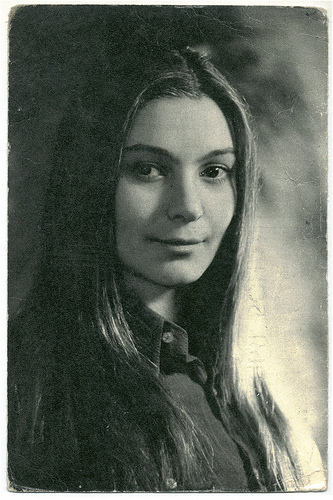
Natalya Bondarchuck. Postcard. Collection: Manuel Palomino Arjona.
People's Actor of the USSR
About Donatas Banionis' later career, Steve Shelokhonov writes at IMDb : “Donatas Banionis constituted the link between cinema of the past and contemporary Lithuanian film. He showed reserved and convincing work in the role of 'The old man' in Kiemas/Courtyard (Valdas Navasaitis, 1999), a reflective film about a Lithuanian father and his family's depressing fate in the Soviet Union of the 1970s.
He worked with director Aleksandr Buravskiy in Leningrad/Attack on Leningrad (2006), a film about the historic siege during the Second World War. Here his acting partners were e.g. Gabriel Byrne, Mira Sorvino, Aleksandr Abdulov, Kirill Lavrov, and Mikhail Efremov.”
During his 65 years of acting Banionis played over 50 roles in film and on television, and over 100 stage parts, mainly at the Panevezys Juozas Miltinis' Drama Theatre, which was frequented by Donatas' fans from all over the former Soviet Union. He also acted in Vilnius at the Lithuanian National Drama Theatre.
Banionis was designated People's Actor of the USSR (1974), and People's actor of the Lithuanian Republic (1973). He was Chevalier of the Order of the Lithuanian Grand Duke Gediminas.
On 4 September 2014, Donatas Banionis passed away in a hospital in Vilnius (though Shelokhonov at IMDb states it was in his hometown Panevėžys). He died of a stroke he suffered two days earlier. Banionis was 90 years old. He had been married to Ona Konkuleviciute and they had two children.
President Putin expressed his condolences in a message to Banionis’s son Raimundas: “Russians sincerely share your deep sorrow. “We all remembered and loved Donatas Banionis, valued his talent, amazing acting technique and personal charisma, and his inimitable theatrical and cinematic works.”
A scene from Solyaris/Solaris (1972). Source: PurpleGardenWalls (YouTube).
Sources: (IMDb), FRERL, The Daily Beast, Wikipedia (English and Dutch), .

Soviet-Russian postcard.
Russian James Bond
Donatas Banionis was born in Lithuania's central city of Kaunas, in 1924. His mother, Blazhaitite-Banionene Ona, was a homemaker. His father, Juozas Banionis, was a tailor who took part in the Russian Revolution of 1917, was wounded in the Russian Civil War, then became a political prisoner, and briefly emigrated to Brazil during the 1920s. Young Banionis was raised with his elder sister during the years of Lithuanian independence before WWII.
After visiting the Kaunas School of Crafts, Banionis began his acting career at the age of 17 at the Drama Theatre of Panevėžys, where his first teacher was Juozas Miltinis.
In 1959, he started to act in films. He made his film debut in the Lithuanian film Adomas nori buti zmogumi/Adam Wants To Be A Human (Vytautas Zalakevicius, 1959). His performance of the farmer Vaitkus in Niekas nenorėjo mirti/Nobody Wanted to Die (Vytautas Žalakevičius, 1965) won him the award for best actor at the Karlovy Vary film festival. Soon he was a highly requested actor, with many parts in prestigious national and international productions.
He played Ladeinikov, a James Bond-like intelligence agent in in the Soviet spy film Myortvyy sezon/Dead Season (Savva Kulish, 1966). This role reportedly inspired Vladimir Putin in his choice to become a KGB officer. When years later, Banionis met the Russian president at the Kremlin, the actor asked if it was true that his character influenced his choice of profession. Putin laughed and said, “Yes, I suppose you can say that.”
Banionis had a supporting part in Mikhail Kalatozov’s Italo-Russian production Krasnaja palatka/The Red Tent (1969), The film is based on the story of Roald Amundsen's ( Sean Connery ) expedition to rescue Umberto Nobile (Peter Finch) and the other survivors of the crash of the Airship Italia.
He also played the title roles of Francisco Goya of the USSR-GDR coproduction Goya – oder der arge Weg der Erkenntnis/Goya or the Hard Way to Enlightenment (Konrad Wolf, 1971), and Ludwig van Beethoven in the DEFA-production Beethoven - Tage aus einem Leben/Beethoven-Days in a Life (Horst Seemann, 1976).

Sean Connery . French postcard by PSG, no. 454, offered by Corvisart, Epinal. Photo: Lynx.
The Planet Solaris
Donatas Banionis played a supporting part in Grigori Kozintsev’s drama Korol Lir/King Lear (1971), based on William Shakespeare's play King Lear. The film featured the Estonian actor Jüri Järvet, who would play again opposite Banionis in his most well-known film part.
Banionis played Kris Kelvin in Andrei Tarkovsky’s remarkable Science-Fiction film Solyaris/Solaris (1972), based on Stanislaw Lem’s novel.
Kelvin, a psychologist, is sent to a space station placed in the orbit around the planet Solaris, where the two surviving scientists of five (three committed suicide) tell him that the ocean of the planet is capable to fulfil their wishes. Kelvin meets his dead wife Hari (Natalya Bondarchuk), tries to kill this phantom but fails to do so, and she becomes more and more real, even if lacking a memory. The phantoms prove to be the products of the planet, communicating with the humans.
In the end Kelvin returns to Earth. Or is this Earth also a simulation? Tarkovsky thus stressed the limits of knowledge, the reality behind reality, and the subjectivity of perception.
The film premiered at the 1972 Cannes film festival, won the Grand Prix Spécial du Jury and was nominated for the Palme d'Or. It premiered in the Soviet Union in 1973.
In 2002 a remake of the film was made by Steven Soderbergh, Solaris, starring George Clooney. Dreading the making of this remake, in 2002 Salman Rushdie praised Tarkovsky’s original as an “exploration of the unreliability of reality and the power of the human unconscious, the great examination of the limits of rationalism and the perverse power of even the most ill-fated love”.

Natalya Bondarchuck. Postcard. Collection: Manuel Palomino Arjona.
People's Actor of the USSR
About Donatas Banionis' later career, Steve Shelokhonov writes at IMDb : “Donatas Banionis constituted the link between cinema of the past and contemporary Lithuanian film. He showed reserved and convincing work in the role of 'The old man' in Kiemas/Courtyard (Valdas Navasaitis, 1999), a reflective film about a Lithuanian father and his family's depressing fate in the Soviet Union of the 1970s.
He worked with director Aleksandr Buravskiy in Leningrad/Attack on Leningrad (2006), a film about the historic siege during the Second World War. Here his acting partners were e.g. Gabriel Byrne, Mira Sorvino, Aleksandr Abdulov, Kirill Lavrov, and Mikhail Efremov.”
During his 65 years of acting Banionis played over 50 roles in film and on television, and over 100 stage parts, mainly at the Panevezys Juozas Miltinis' Drama Theatre, which was frequented by Donatas' fans from all over the former Soviet Union. He also acted in Vilnius at the Lithuanian National Drama Theatre.
Banionis was designated People's Actor of the USSR (1974), and People's actor of the Lithuanian Republic (1973). He was Chevalier of the Order of the Lithuanian Grand Duke Gediminas.
On 4 September 2014, Donatas Banionis passed away in a hospital in Vilnius (though Shelokhonov at IMDb states it was in his hometown Panevėžys). He died of a stroke he suffered two days earlier. Banionis was 90 years old. He had been married to Ona Konkuleviciute and they had two children.
President Putin expressed his condolences in a message to Banionis’s son Raimundas: “Russians sincerely share your deep sorrow. “We all remembered and loved Donatas Banionis, valued his talent, amazing acting technique and personal charisma, and his inimitable theatrical and cinematic works.”
A scene from Solyaris/Solaris (1972). Source: PurpleGardenWalls (YouTube).
Sources: (IMDb), FRERL, The Daily Beast, Wikipedia (English and Dutch), .
Published on September 07, 2014 23:00
September 6, 2014
Incompreso (1966)
Today's film special is about the Italian drama Incompreso/Misunderstood (Luigi Comencini, 1966), a film from my youth. I saw it a the local youth film club: on six Wednesday afternoons, we, school kids, went without our parents to a real cinema. Normally we saw an animation film or a Jerry Lewis comedy, but that one afternoon we saw a heart-breaking drama. At the end of the film, the whole under aged audience was in tears. Incompreso - a sweet memory.
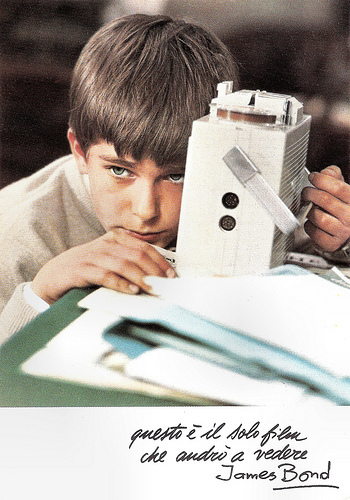
Italian postcard. Photo: publicity still for Incompreso/Misunderstood (Luigi Comencini, 1966) with Stefano Colagrande. Caption: "Questo è il solo film che andro a vedere. James Bond" (This is the only movie I'll go to see. James Bond).
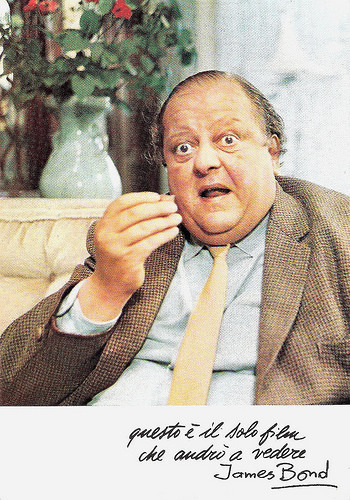
Italian postcard. Photo: publicity still for Incompreso/Misunderstood (Luigi Comencini, 1966) with John Sharp. Caption: "Questo è il solo film che andro a vedere. James Bond" (This is the only movie I'll go to see. James Bond).
At the end when tragedy strikes
In the Italian Coming-of-Age drama Incompreso/Misunderstood (Luigi Comencini, 1966), Anthony Quayle plays John Duncombe, the UK Consul General in Florence, Italy.
Duncombe becomes a widower when his two sons, Andrew and Miles, are still young kids. Andrew (Stefano Colagrande), the eldest, reacts with adult maturity to the loss of his mother, looking after little Miles (Simone Giannozzi).
Andrew's brave front convinces his father that he is unaffected by his mother's death. Playmate and protector of his little brother, the boy takes all the blame when their mischief goes wrong.
Their father is often absent, both physically and emotionally, especially towards Andrew. At the end when tragedy strikes, Duncombe finally recognize his son's true qualities.
Incompreso was an adaptation of the book Misunderstood (1869) written by the English novelist Florence Montgomery.
The film earned director Luigi Comencini his first David di Donatello award and a nomination for the Golden Palm at the Cannes Film Festival.
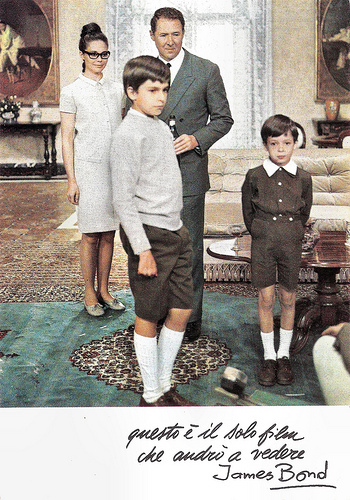
Italian postcard. Photo: publicity still for Incompreso/Misunderstood (Luigi Comencini, 1966) with Stefano Colagrande and Simone Giannozzi in forground and with Anthony Quayle. Caption: "Questo è il solo film che andro a vedere. James Bond" (This is the only movie I'll go to see. James Bond).
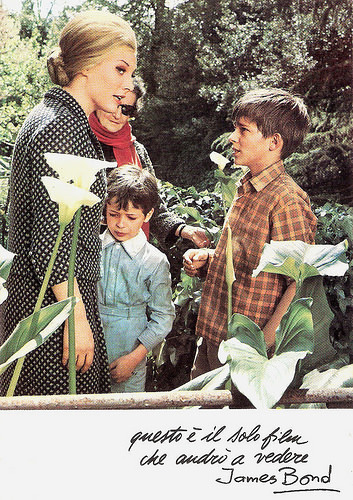
Italian postcard. Photo: publicity still for Incompreso/Misunderstood (Luigi Comencini, 1966) with Stefano Colagrande at right and Simone Giannozzi in the middle. Caption: "Questo è il solo film che andro a vedere. James Bond" (This is the only movie I'll go to see. James Bond).
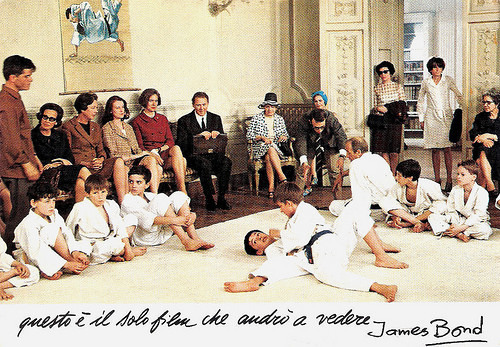
Italian postcard. Photo: publicity still for Incompreso/Misunderstood (Luigi Comencini, 1966) with Stefano Colagrande and Simone Giannozzi in forground and with Anthony Quayle. Caption: "Questo è il solo film che andro a vedere. James Bond" (This is the only movie I'll go to see. James Bond).
Sources: Gino Moliterno (Historical Dictionary of Italian Cinema), TheSpyKid.com, Wikipedia and IMDb.

Italian postcard. Photo: publicity still for Incompreso/Misunderstood (Luigi Comencini, 1966) with Stefano Colagrande. Caption: "Questo è il solo film che andro a vedere. James Bond" (This is the only movie I'll go to see. James Bond).

Italian postcard. Photo: publicity still for Incompreso/Misunderstood (Luigi Comencini, 1966) with John Sharp. Caption: "Questo è il solo film che andro a vedere. James Bond" (This is the only movie I'll go to see. James Bond).
At the end when tragedy strikes
In the Italian Coming-of-Age drama Incompreso/Misunderstood (Luigi Comencini, 1966), Anthony Quayle plays John Duncombe, the UK Consul General in Florence, Italy.
Duncombe becomes a widower when his two sons, Andrew and Miles, are still young kids. Andrew (Stefano Colagrande), the eldest, reacts with adult maturity to the loss of his mother, looking after little Miles (Simone Giannozzi).
Andrew's brave front convinces his father that he is unaffected by his mother's death. Playmate and protector of his little brother, the boy takes all the blame when their mischief goes wrong.
Their father is often absent, both physically and emotionally, especially towards Andrew. At the end when tragedy strikes, Duncombe finally recognize his son's true qualities.
Incompreso was an adaptation of the book Misunderstood (1869) written by the English novelist Florence Montgomery.
The film earned director Luigi Comencini his first David di Donatello award and a nomination for the Golden Palm at the Cannes Film Festival.

Italian postcard. Photo: publicity still for Incompreso/Misunderstood (Luigi Comencini, 1966) with Stefano Colagrande and Simone Giannozzi in forground and with Anthony Quayle. Caption: "Questo è il solo film che andro a vedere. James Bond" (This is the only movie I'll go to see. James Bond).

Italian postcard. Photo: publicity still for Incompreso/Misunderstood (Luigi Comencini, 1966) with Stefano Colagrande at right and Simone Giannozzi in the middle. Caption: "Questo è il solo film che andro a vedere. James Bond" (This is the only movie I'll go to see. James Bond).

Italian postcard. Photo: publicity still for Incompreso/Misunderstood (Luigi Comencini, 1966) with Stefano Colagrande and Simone Giannozzi in forground and with Anthony Quayle. Caption: "Questo è il solo film che andro a vedere. James Bond" (This is the only movie I'll go to see. James Bond).
Sources: Gino Moliterno (Historical Dictionary of Italian Cinema), TheSpyKid.com, Wikipedia and IMDb.
Published on September 06, 2014 23:00
September 5, 2014
Dancers in silent cinema
An interesting aspect of the European silent cinema is the contribution by dancers. Their delicate gestures and expressive movements were often a visual delight among the theatrical bombast of the grand gesticulations in the early films. Their exotic and sometimes suggestive dances were welcome intermissions in many dreary productions but also in the side programmes of the bigger cinemas. Some of them would become legendary stars of the European Cinema, like trained dancer and former Ziegfeld Follies girl Louise Brooks, Leni Riefenstahl - who was trained by noted modern dance pioneer Mary Wigman or former revue dancer Lilian Harvey. Many others of these dancers were soon forgotten. Their expressive postcards have survived and are now collected by such admirers as Didier Hanson. Today a tribute to these forgotten artists who once danced in the silent European cinema.
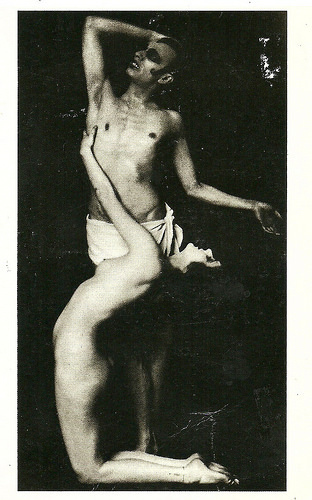
Anita Berber and Sebastian Droste. Vintage postcard. Collection: Didier Hanson.
Expressionistic dancer and film actress Anita Berber (1899–1928) challenged many taboos during the Weimar period. With her drug and booze addiction and her bisexual affairs, she epitomized the decadence of 1920s Berlin. Her charcoaled eyes, her black lipstick and bright red, bobbed hair were featured on a famous portrait of her by Otto Dix and in silent films by Richard Oswald and Fritz Lang.
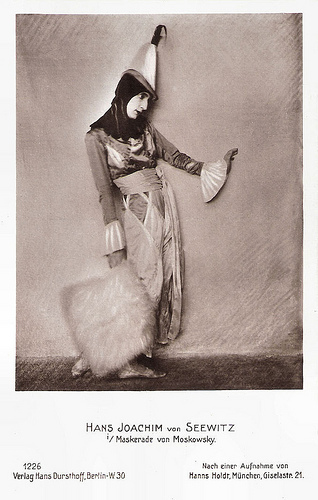
Hans Joachim von Seewitz in Maskerade by Moskowsky. German postcard by Verlag Hans Dursthoff, Berlin, no. 1226. Photo: Hans Holdt, München.
Joachim von Seewitz (1891-1966) was a German 'Ausdruckstänzer' (Expressionist dancer). In the 1920s and 1930s, he celebrated world successes and was well known to international audiences. In 1934, Von Seewitz was a member and soloist of the Berlin Florence-Ballett which performed in the major variety shows and in the new Ufa movie palaces.
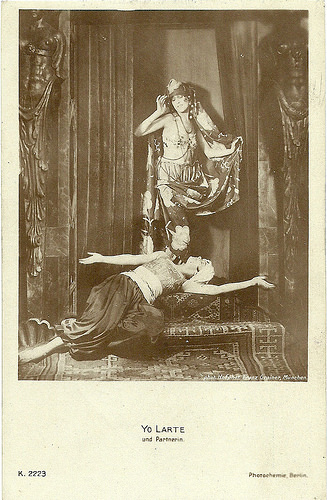
Yo Larte and partner. German postcard by Photochemie, Berlin, no. K 2223. Photo: Hof photograph Franz Greiner, München. Collection: Didier Hanson.
Dancer Yo Larte appeared in three silent German films directed by graphic designer, author and film director Edmund Edel. She played opposite Emil Jannings in Aus Mangel an Beweisen/Presumed Innocent (Edmund Edel, 1916) and was one of the victims of Ernst Lubitsch in Doktor Satansohn/Doctor Satan Son (Edmund Edel, 1916). She also had a part in Im Joche des Schicksals/In the yokes of Destiny (Edmund Edel, 1916). Edel made also posters for her dance productions.
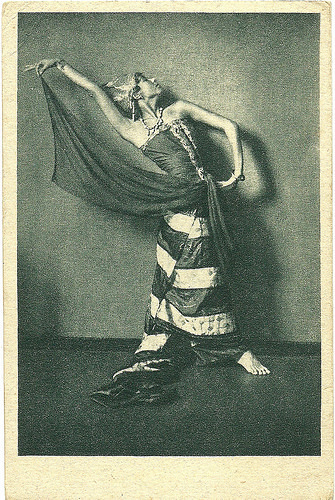
Lisa Kresse. Vintage postcard.
German dancer and actress Lisa Kresse appeared in some remarkable silent film productions. These included feature films like Narr und Tod/Fool and death (Rudolf Stiaßny, 1920), Das Geheimnis des Buddha/The secret of the Buddha (Philipp Lothar Mayring, 1920), and Der Einäugige/The one-eyed (Josef Coenen, 1921). As a dancer she posed for photographs by Hugo Erfurth.
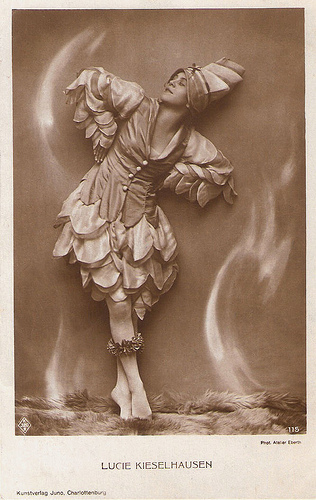
Lucy Kieselhausen. German postcard by Kunstverlag Juno, Charlottenburg, no. 115. Photo: Atelier Eberth.
Austrian dancer Lucy Kieselhausen (1900 – 1926 or 1927) had a successful career on the German stages and appeared in three silent films. Only in her twenties, she died by a tragic accident in her bathroom.
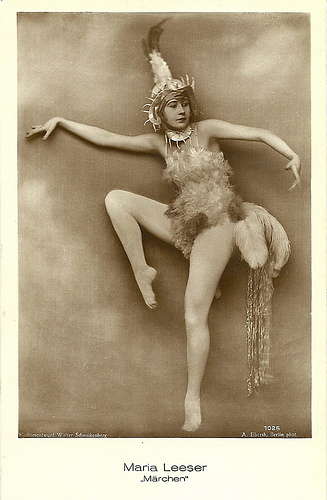
Maria Leeser. German postcard, no. 1025. Photo: A. Eberth, Berlin. Costume design: Walter Schnackenberg. Caption: Märchen (Fairytales). Collection: Didier Hanson.
During the 1920s, Maria Leeser formed a popular ballet team with Hasso Holm in Germany.
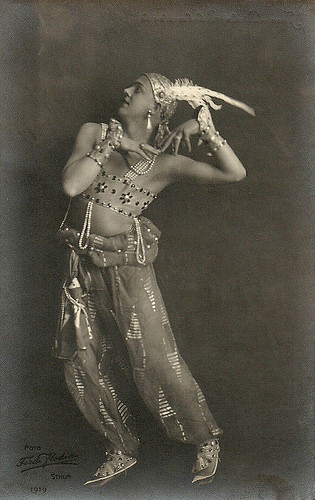
Jean Börlin. Vintage postcard. Photo: Ferdy Flodin, 1919. Collection: Didier Hanson.
Swedish choreographer and dancer Jean Börlin (1893–1930) started as one of the most outstanding dancers of the Stockholm Opera and after meeting Mikhail Fokine, he became an international ballet star. He also appeared in three silent classics of the French cinema: Entr'acte (René Clair, 1924), L'inhumaine/The New Enchantment (Marcel L'Herbier, 1924) and Le voyage imaginaire/The Imaginary Voyage (René Clair, 1926).
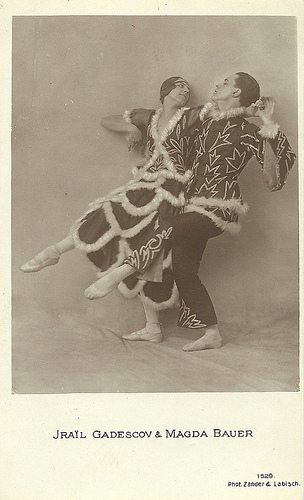
Iraïl Gadescov. German postcard, no. 1529. Photo: Zander & Labisch. Collection: Didier Hanson.
Iraïl Gadescov was the exotic stage name of the Dutch dancer Richard Vogelesang (1894-1970), who enjoyed an international career. During the 1920s he often performed together with German dancer Magda Bauer. In 1921, Gadescov danced in the German silent film Die Diktatur der Liebe. 1. Die böse Lust/The dictatorship of love I - The evil desire (Willy Zeyn, 1921), credited as Jrail Godescou.
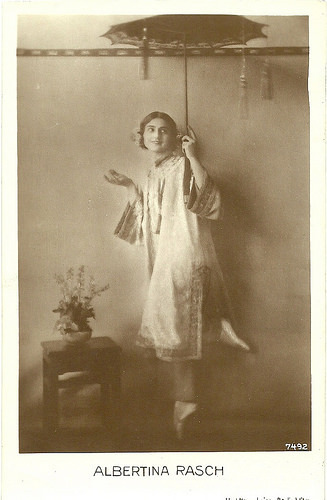
Albertina Rasch. German postcard, no. 7492. Collection: Didier Hanson.
Albertina Rasch (1891-1967) was an Austrian-American dancer and choreographer. Rasch studied at the Vienna State Opera Ballet school and became leading ballerina at the New York Hippodrome in 1911. She formed her own dance troupe, starred in a number of Ziegfeld productions, appeared at the Moulin Rouge, performed with Josephine Baker, toured with Sarah Bernhardt , and opened a Manhattan dance studio (where Bill Robinson taught tap) . She also appeared in a number of films, including the Austtrian films Zigeunerliebe/Gypsy Love (Thomas E. Walsh, 1922) and Frauenopfer/Dolores (Leo de Valery, 1923). Later she adapted her classical training and techniques for the Broadway theatre and films like The Merry Widow (Ernst Lubitsch, 1934) and Marie Antoinette (W.S. van Dyke, 1938) .
Source: Wikipedia and

Anita Berber and Sebastian Droste. Vintage postcard. Collection: Didier Hanson.
Expressionistic dancer and film actress Anita Berber (1899–1928) challenged many taboos during the Weimar period. With her drug and booze addiction and her bisexual affairs, she epitomized the decadence of 1920s Berlin. Her charcoaled eyes, her black lipstick and bright red, bobbed hair were featured on a famous portrait of her by Otto Dix and in silent films by Richard Oswald and Fritz Lang.

Hans Joachim von Seewitz in Maskerade by Moskowsky. German postcard by Verlag Hans Dursthoff, Berlin, no. 1226. Photo: Hans Holdt, München.
Joachim von Seewitz (1891-1966) was a German 'Ausdruckstänzer' (Expressionist dancer). In the 1920s and 1930s, he celebrated world successes and was well known to international audiences. In 1934, Von Seewitz was a member and soloist of the Berlin Florence-Ballett which performed in the major variety shows and in the new Ufa movie palaces.

Yo Larte and partner. German postcard by Photochemie, Berlin, no. K 2223. Photo: Hof photograph Franz Greiner, München. Collection: Didier Hanson.
Dancer Yo Larte appeared in three silent German films directed by graphic designer, author and film director Edmund Edel. She played opposite Emil Jannings in Aus Mangel an Beweisen/Presumed Innocent (Edmund Edel, 1916) and was one of the victims of Ernst Lubitsch in Doktor Satansohn/Doctor Satan Son (Edmund Edel, 1916). She also had a part in Im Joche des Schicksals/In the yokes of Destiny (Edmund Edel, 1916). Edel made also posters for her dance productions.

Lisa Kresse. Vintage postcard.
German dancer and actress Lisa Kresse appeared in some remarkable silent film productions. These included feature films like Narr und Tod/Fool and death (Rudolf Stiaßny, 1920), Das Geheimnis des Buddha/The secret of the Buddha (Philipp Lothar Mayring, 1920), and Der Einäugige/The one-eyed (Josef Coenen, 1921). As a dancer she posed for photographs by Hugo Erfurth.

Lucy Kieselhausen. German postcard by Kunstverlag Juno, Charlottenburg, no. 115. Photo: Atelier Eberth.
Austrian dancer Lucy Kieselhausen (1900 – 1926 or 1927) had a successful career on the German stages and appeared in three silent films. Only in her twenties, she died by a tragic accident in her bathroom.

Maria Leeser. German postcard, no. 1025. Photo: A. Eberth, Berlin. Costume design: Walter Schnackenberg. Caption: Märchen (Fairytales). Collection: Didier Hanson.
During the 1920s, Maria Leeser formed a popular ballet team with Hasso Holm in Germany.

Jean Börlin. Vintage postcard. Photo: Ferdy Flodin, 1919. Collection: Didier Hanson.
Swedish choreographer and dancer Jean Börlin (1893–1930) started as one of the most outstanding dancers of the Stockholm Opera and after meeting Mikhail Fokine, he became an international ballet star. He also appeared in three silent classics of the French cinema: Entr'acte (René Clair, 1924), L'inhumaine/The New Enchantment (Marcel L'Herbier, 1924) and Le voyage imaginaire/The Imaginary Voyage (René Clair, 1926).

Iraïl Gadescov. German postcard, no. 1529. Photo: Zander & Labisch. Collection: Didier Hanson.
Iraïl Gadescov was the exotic stage name of the Dutch dancer Richard Vogelesang (1894-1970), who enjoyed an international career. During the 1920s he often performed together with German dancer Magda Bauer. In 1921, Gadescov danced in the German silent film Die Diktatur der Liebe. 1. Die böse Lust/The dictatorship of love I - The evil desire (Willy Zeyn, 1921), credited as Jrail Godescou.

Albertina Rasch. German postcard, no. 7492. Collection: Didier Hanson.
Albertina Rasch (1891-1967) was an Austrian-American dancer and choreographer. Rasch studied at the Vienna State Opera Ballet school and became leading ballerina at the New York Hippodrome in 1911. She formed her own dance troupe, starred in a number of Ziegfeld productions, appeared at the Moulin Rouge, performed with Josephine Baker, toured with Sarah Bernhardt , and opened a Manhattan dance studio (where Bill Robinson taught tap) . She also appeared in a number of films, including the Austtrian films Zigeunerliebe/Gypsy Love (Thomas E. Walsh, 1922) and Frauenopfer/Dolores (Leo de Valery, 1923). Later she adapted her classical training and techniques for the Broadway theatre and films like The Merry Widow (Ernst Lubitsch, 1934) and Marie Antoinette (W.S. van Dyke, 1938) .
Source: Wikipedia and
Published on September 05, 2014 23:00
September 4, 2014
Robert Helpmann
Sir Robert Helpmann CBE (1909-1986) was an Australian dancer, actor, theatre director and choreographer. Helpmann appeared in many films, including the two Powell and Pressburger ballet films The Red Shoes (1948), for which he was the choreographer, and The Tales of Hoffmann (1951).
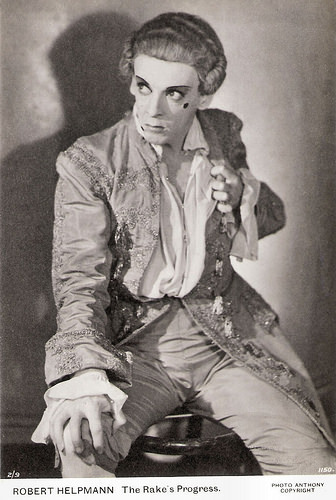
British postcard. Photo: Gordon Anthony. Publicity still for the Sadler's Wells ballet production The Rake's Progress.
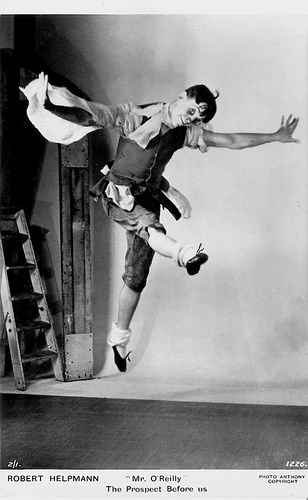
British postcard, no. 1226. Photo: Gordon Anthony. Publicity still for the ballet production The Prospect Before Us with Robert Helpmann as Mr. O' Reilly. Part of a collection of portraits of Robert Helpmann on stage.
The Red Shoes
Robert Helpmann was born Robert Murray Helpman (spelt with one n) in Mount Gambier, South Australia, in 1909. His parents were James Murray Helpman a Victorian-born stock and station agent, and his wife Mary, née Gardiner. He had a younger sister Sheila Mary Helpman, and a younger brother Max, or Maxwell Gardiner Helpman, who both later became actors.
‘Bobby’ was dark-haired, pale, and had large dark eyes. He was educated at Prince Alfred College, Adelaide, but left school at 14. From childhood, Helpmann had a strong desire to be a dancer. This was an unusual ambition in provincial Australia of the 1920s. His mother—herself stage - struck from an early age — was to be a driving force in his career.
Helpmann was taught ballet by Nora Stewart. According to Wikipedia , she taught him the moves and dances of a girl because she had no prior experience teaching boys. He first danced solo at the Theatre Royal, Adelaide in The Ugly Duckling in 1922. In 1926 he joined as a student the touring dance company of the Russian ballerina Anna Pavlova. The introduction came via his father, who was on a business trip to Melbourne, where he met Pavlova who was dancing there.
His professional career began in 1927 when he joined the British J. C. Williamson Ltd as the principal dancer in Frasquita for its Australasian tour. In Britain, he went on to become the principal dancer at the Sadler’s Wells ballet (now the Royal Ballet) from 1933 to 1950. During the 1930s some of the ballets in which he danced were televised by the BBC, including Job (1936) in the important role of Satan.
In 1937 he created an enduring partnership with Margot Fonteyn. They were a popular pair, particularly during World War II, and danced a large classical repertoire.
In the 1940s, as he passed his peak as a dancer, Helpmann turned to production and to acting. He produced his own ballets — Comus (1942), Hamlet (1942), The Birds (1942), Miracle in the Gorbals (1944), Caravan (1946), and Adam Zero (1946).
The highpoint of Helpmann's career as a dancer was the Sadler's Wells Ballet tour of the United States in 1949, with Fonteyn and Helpmann dancing the leading roles in The Sleeping Beauty. The production caused a sensation, which made the names of both the Royal Ballet and its two principals; public and press alike referred to them affectionately as Bobby and Margot. Although Helpmann was past his best as a dancer, the tour opened doors for him in the United States as an actor and director.
In 1942 he played the Dutch Quisling in the Powell/Pressburger film One of Our Aircraft Is Missing (Michael Powell, Emeric Pressburger, 1942). The film follows the fortunes of six British airmen shot down over Holland as they try to make their way to the coast and back to England.
He then played the Bishop of Ely in the Shakespeare adaptation Henry V ( Laurence Olivier , 1944).
Helpmann then played the principal dancer role of Ivan Boleslawsky in the first British ballet film The Red Shoes (Michael Powell, Emeric Pressburger, 1948). For this very successful film he was also the choreographer. The team followed it up with another ballet film, The Tales of Hoffmann (Michael Powell, Emeric Pressburger, 1951).
He later played the Chinese Prince Tuan in 55 Days at Peking (Nicholas Ray, Guy Green, 1963). On stage, he performed roles from Shakespeare at the Canadian Stratford Shakespeare Festival and at the Old Vic theatre company in London, playing the title role in Hamlet two years after having danced the same part. In 1963, he directed the world tour of Margot Fonteyn.
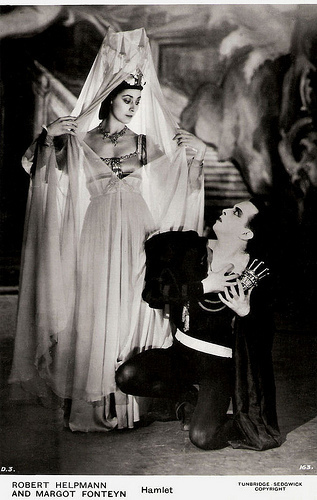
British postcard, no. 163. Photo: Tunbridge - Sedgwick. Publicity still for the ballet production Hamlet with Margot Fonteyn and Robert Helpmann as Ophelia and Hamlet, c. 1942.
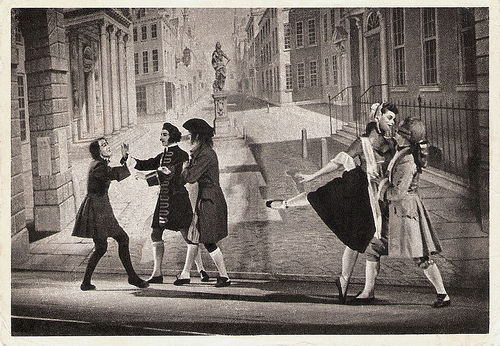
British postcard by Ward Gallery, no. 601. Photo: Merlyn Severn. Publicity still for the ballet production The Rake's Progress with Robert Helpmann and Julia Farron.
Gay and Flamboyant
In 1965 Robert Helpmann returned to Australia to become co-director of the Australian Ballet, bringing with him an international theatrical reputation and connections with dancers, choreographers and companies across the world. He created a series of important choreographic works and led the company on several international tours.
Since he was gay and flamboyant, his arrival in very conservative Australia caused some consternation, according to Wikipedia . Australians were proud of his international fame, but not sure what to make of him personally.
Helpmann joined Dame Peggy van Praagh at the helm of the fledgling company, as her co-director until 1974 and sole director until 1976. He choreographed ballets including Yugen (1965), Elektra (1967, revised from the original version created for the Royal Ballet in 1963), Sun Music (1968), Perisynthyon (1974) and produced and directed The Merry Widow (1975).
He continued to appear in films. One of his most recognized screen roles is the sinister Child Catcher in the family classic Chitty Chitty Bang Bang (Ken Hughes, 1968).
Another family film he starred in was Alice's Adventures in Wonderland (William Sterling, 1972), in which he portrayed the Mad Hatter opposite the young Fiona Fullerton as Alice.
And for The Australian Ballet he co-directed with Rudolf Nureyev the ballet-film Don Quixote (1973), in which he also played the title role.
In 1938, Helpmann had met a young Oxford undergraduate while fulfilling an invitation to dance at the university. He was immediately drawn to the handsome and intelligent Michael Benthall, and the pair formed a relationship that was to last for 36 years until Benthall's death in 1974. The couple lived and often worked together quite openly for the time.
Although devastated by the loss of his longtime companion and collaborator, ‘Sir Bobby’ continued to act, direct and produce. Among his later films is the Australian horror film Patrick (Richard Franklin, 1978), with Susan Penhaligon. He made various guest appearances in ballets in Australia and abroad.
At 77, Robert Helpmann died in Sydney in 1986. In 1964 he had been appointed a Commander of the Order of the British Empire (CBE). In 1965 he was named ‘Australian of the Year’ and in 1968 he was appointed a Knight Bachelor (KBE).
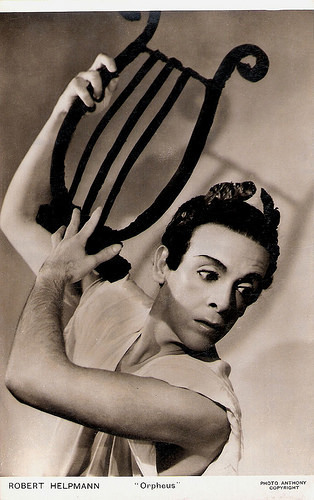
British postcard. Photo: Gordon Anthony. Publicity still for the Sadler's Wells ballet production Orpheus and Eurydice (1941) with Robert Helpmann as Orpheus.
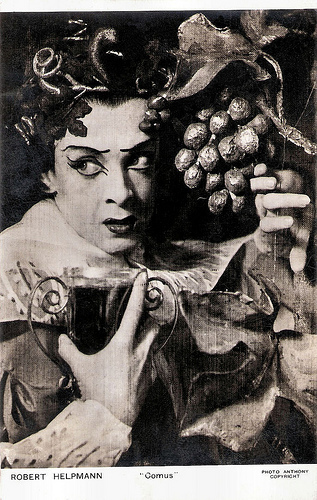
British postcard. Photo: Gordon Anthony. Publicity still for the Sadler's Wells ballet production Comus (1942) with Robert Helpmann in the title role.
Sources: Christopher Sexton (Australian Dictionary of Biography), (IMDb), Encyclopaedia Britannica, Wikipedia and .

British postcard. Photo: Gordon Anthony. Publicity still for the Sadler's Wells ballet production The Rake's Progress.

British postcard, no. 1226. Photo: Gordon Anthony. Publicity still for the ballet production The Prospect Before Us with Robert Helpmann as Mr. O' Reilly. Part of a collection of portraits of Robert Helpmann on stage.
The Red Shoes
Robert Helpmann was born Robert Murray Helpman (spelt with one n) in Mount Gambier, South Australia, in 1909. His parents were James Murray Helpman a Victorian-born stock and station agent, and his wife Mary, née Gardiner. He had a younger sister Sheila Mary Helpman, and a younger brother Max, or Maxwell Gardiner Helpman, who both later became actors.
‘Bobby’ was dark-haired, pale, and had large dark eyes. He was educated at Prince Alfred College, Adelaide, but left school at 14. From childhood, Helpmann had a strong desire to be a dancer. This was an unusual ambition in provincial Australia of the 1920s. His mother—herself stage - struck from an early age — was to be a driving force in his career.
Helpmann was taught ballet by Nora Stewart. According to Wikipedia , she taught him the moves and dances of a girl because she had no prior experience teaching boys. He first danced solo at the Theatre Royal, Adelaide in The Ugly Duckling in 1922. In 1926 he joined as a student the touring dance company of the Russian ballerina Anna Pavlova. The introduction came via his father, who was on a business trip to Melbourne, where he met Pavlova who was dancing there.
His professional career began in 1927 when he joined the British J. C. Williamson Ltd as the principal dancer in Frasquita for its Australasian tour. In Britain, he went on to become the principal dancer at the Sadler’s Wells ballet (now the Royal Ballet) from 1933 to 1950. During the 1930s some of the ballets in which he danced were televised by the BBC, including Job (1936) in the important role of Satan.
In 1937 he created an enduring partnership with Margot Fonteyn. They were a popular pair, particularly during World War II, and danced a large classical repertoire.
In the 1940s, as he passed his peak as a dancer, Helpmann turned to production and to acting. He produced his own ballets — Comus (1942), Hamlet (1942), The Birds (1942), Miracle in the Gorbals (1944), Caravan (1946), and Adam Zero (1946).
The highpoint of Helpmann's career as a dancer was the Sadler's Wells Ballet tour of the United States in 1949, with Fonteyn and Helpmann dancing the leading roles in The Sleeping Beauty. The production caused a sensation, which made the names of both the Royal Ballet and its two principals; public and press alike referred to them affectionately as Bobby and Margot. Although Helpmann was past his best as a dancer, the tour opened doors for him in the United States as an actor and director.
In 1942 he played the Dutch Quisling in the Powell/Pressburger film One of Our Aircraft Is Missing (Michael Powell, Emeric Pressburger, 1942). The film follows the fortunes of six British airmen shot down over Holland as they try to make their way to the coast and back to England.
He then played the Bishop of Ely in the Shakespeare adaptation Henry V ( Laurence Olivier , 1944).
Helpmann then played the principal dancer role of Ivan Boleslawsky in the first British ballet film The Red Shoes (Michael Powell, Emeric Pressburger, 1948). For this very successful film he was also the choreographer. The team followed it up with another ballet film, The Tales of Hoffmann (Michael Powell, Emeric Pressburger, 1951).
He later played the Chinese Prince Tuan in 55 Days at Peking (Nicholas Ray, Guy Green, 1963). On stage, he performed roles from Shakespeare at the Canadian Stratford Shakespeare Festival and at the Old Vic theatre company in London, playing the title role in Hamlet two years after having danced the same part. In 1963, he directed the world tour of Margot Fonteyn.

British postcard, no. 163. Photo: Tunbridge - Sedgwick. Publicity still for the ballet production Hamlet with Margot Fonteyn and Robert Helpmann as Ophelia and Hamlet, c. 1942.

British postcard by Ward Gallery, no. 601. Photo: Merlyn Severn. Publicity still for the ballet production The Rake's Progress with Robert Helpmann and Julia Farron.
Gay and Flamboyant
In 1965 Robert Helpmann returned to Australia to become co-director of the Australian Ballet, bringing with him an international theatrical reputation and connections with dancers, choreographers and companies across the world. He created a series of important choreographic works and led the company on several international tours.
Since he was gay and flamboyant, his arrival in very conservative Australia caused some consternation, according to Wikipedia . Australians were proud of his international fame, but not sure what to make of him personally.
Helpmann joined Dame Peggy van Praagh at the helm of the fledgling company, as her co-director until 1974 and sole director until 1976. He choreographed ballets including Yugen (1965), Elektra (1967, revised from the original version created for the Royal Ballet in 1963), Sun Music (1968), Perisynthyon (1974) and produced and directed The Merry Widow (1975).
He continued to appear in films. One of his most recognized screen roles is the sinister Child Catcher in the family classic Chitty Chitty Bang Bang (Ken Hughes, 1968).
Another family film he starred in was Alice's Adventures in Wonderland (William Sterling, 1972), in which he portrayed the Mad Hatter opposite the young Fiona Fullerton as Alice.
And for The Australian Ballet he co-directed with Rudolf Nureyev the ballet-film Don Quixote (1973), in which he also played the title role.
In 1938, Helpmann had met a young Oxford undergraduate while fulfilling an invitation to dance at the university. He was immediately drawn to the handsome and intelligent Michael Benthall, and the pair formed a relationship that was to last for 36 years until Benthall's death in 1974. The couple lived and often worked together quite openly for the time.
Although devastated by the loss of his longtime companion and collaborator, ‘Sir Bobby’ continued to act, direct and produce. Among his later films is the Australian horror film Patrick (Richard Franklin, 1978), with Susan Penhaligon. He made various guest appearances in ballets in Australia and abroad.
At 77, Robert Helpmann died in Sydney in 1986. In 1964 he had been appointed a Commander of the Order of the British Empire (CBE). In 1965 he was named ‘Australian of the Year’ and in 1968 he was appointed a Knight Bachelor (KBE).

British postcard. Photo: Gordon Anthony. Publicity still for the Sadler's Wells ballet production Orpheus and Eurydice (1941) with Robert Helpmann as Orpheus.

British postcard. Photo: Gordon Anthony. Publicity still for the Sadler's Wells ballet production Comus (1942) with Robert Helpmann in the title role.
Sources: Christopher Sexton (Australian Dictionary of Biography), (IMDb), Encyclopaedia Britannica, Wikipedia and .
Published on September 04, 2014 23:00
September 3, 2014
Peter Weck
Austrian actor, theatre impresario and director Peter Weck (1930) appeared in more than 100 films. With his natural acting style in costume dramas and Heimatfilms, he became the Wiener Goldjungen (the Golden Boy from Vienna).
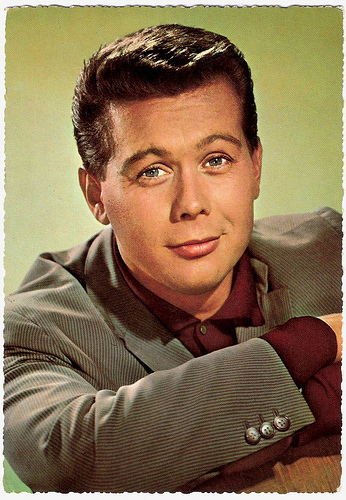
German postcard by Krüger, no. 902/108. Photo: Bavariafilm. Publicity still for Junge Leute brauchen Liebe/Young People Need Love (Géza von Cziffra, 1961).
Star Maker
Peter Weck was born in Wien (Vienna), Austria, in 1930. At the age of 9, he became a member of the famous Wiener Sängerknaben (Vienna Boy's Choir), where he sang as a soprano soloist till 1940.
From 1949 to 1951, he studied piano, clarinet and bassoon at the Universität für Musik und darstellende Kunst Wien (Academy for Music and Performing Arts, Vienna). He stopped his musical studies and instead decided to become an actor. In 1953, he graduated at the Max Reinhardt Seminar of the same academy in Vienna.
After his stage debut in 1953 as Truffaldino in Carlo Goldoni's Servant of Two Masters at the Stadtheater Klagenfurt. During the 1950s, he also performed in Munich, Hamburg and Vienna. From 1959 till 1970, he played at the renowned Burgtheater in Vienna, where he also worked as a director. Between 1965 and 1976, he also worked for the Schauspielhaus in Zurich.
Like Romy Schneider he was discovered for the cinema by star maker Ernst Marischka. In 1954 he made his film debut in Bruder Martin/Brother Martin (Axel von Ambesser, 1954) with Paul Hörbiger .
Weck was often seen in uniform in costume dramas. Refreshingly natural and without pathos he performed such roles as Prince Heinrich von Oranien in Mädchenjahre einer Königin/The Story of Vickie (Ernst Marischka, 1954), and archduke Carl-Ludwig in Sissi (Ernst Marischka, 1955).
He also appeared in many Heimatfilms of the 1950s like Und der Himmel lacht dazu/And Love Laughs at it (Robert A. Stemmle, 1954), and Die Wirtin zur goldenen Krone/The Innkeeper of the Golden Crown ( Theo Lingen , 1955).
In Die liebe Familie/Dear Family (Helmut Weiss, 1957), he combined boyish charm with energy and common sense. This unusual quality for a jeune premier made him soon the beloved Wiener Goldjungen of the German speaking entertainment cinema.
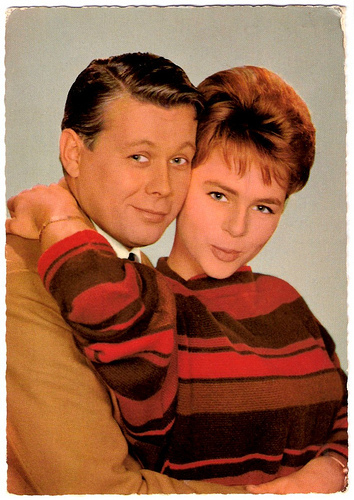
Dutch postcard. Sent by mail in 1964.
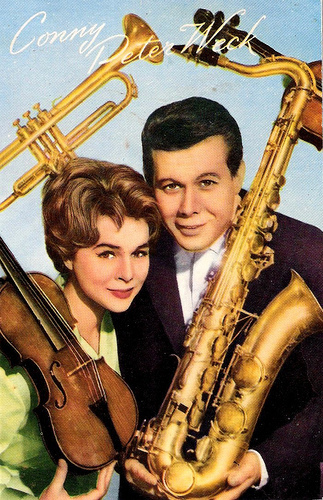
Dutch postcard.
Darling
Peter Weck intensified his film work in the 1960s, and he became a darling of the female public as the sympathetic Filou in Mariandl (Werner Jacobs, 1961) at the side of Conny Froboess .
Peter and Conny were co-stars in a series of Schlagerfilms: Wenn das mein großer Bruder wüßte/When My Big Brother Knew (Erik Ode, 1959), Meine Nichte tut das nicht/My Niece Doesn't Do That (Franz Josef Gottlieb, 1960), Junge Leute brauchen Liebe/Young People Need Love (Géza von Cziffra, 1961), Mariandl (Werner Jacobs, 1961), Der Traum von Lieschen Müller/The Dream of Lieschen Mueller (Helmut Käutner, 1961), Der Vogelhändler/The Bird Seller (Géza von Cziffra, 1962), Mariandls Heimkehr/Mariandl's Return (Werner Jacobs, 1962), and Ist Geraldine ein Engel?/Is Geraldine an Angel? (Steve Previn, 1963).
Stephanie D'heil writes at her website Steffi-line , that the media reported about a relationship between the two young stars, and they even suggested that they were engaged.
But in 1966 Peter Weck met former model Ingrid Muttone in the cafeteria of the Burgtheater. In 1967, she became his wife and they would have two children, Barbara and Philipp Daniel.
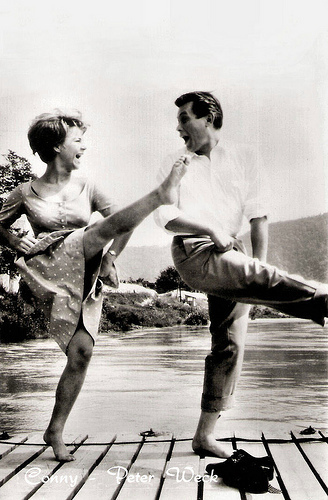
Dutch postcard by Int. Filmpers, Amsterdam, no. WPS 168. Photo: Centrafilm. Publicity still for Mariandl (Werner Jacobs, 1961).
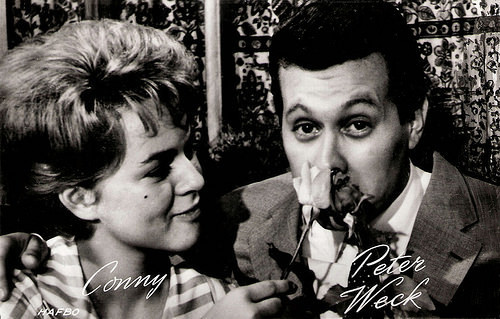
Dutch postcard by Uitgeverij Takken, Utrecht, no. AX 4899. Photo: Hafbo Film. Publicity still for Junge Leute brauchen Liebe/Young People Need Love (Géza von Cziffra, 1961).
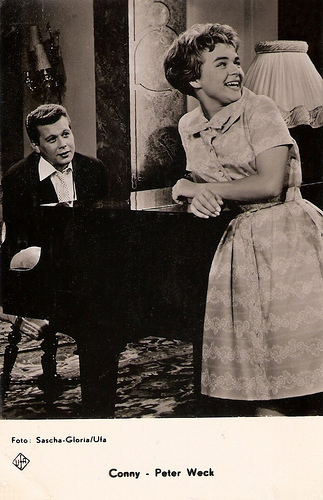
Dutch postcard by Gebr. Spanjersberg N.V., Rotterdam, no. 1314. Photo: Sascha-Gloria/Ufa.
Pater Familias
One of Peter Weck’s best roles was in The Cardinal (Otto Preminger, 1963) opposite Romy Schneider . He played a Jewish man who became so desperate after the Austrian Anschluss in 1938 that he committed suicide by jumping out of the window.
Later Weck worked in light entertainment films by directors like Franz Antel, Franz Josef Gottlieb, Harald Reinl, and especially Harald Vock.
In 1971 he became very popular as the partner of Fritz Eckhardt in the TV series Wenn der Vater mit dem Sohne/When Fathers and Sons. Another popular series was Ich heirate eine Familie/I Married a Family (1983), which he directed, and in which he also performed the role of the pater familias. The series won the Goldene Kamera award twice, in 1985 and 1986.
From 1983 till 1992 he also worked as the impresario of the Theater an der Wien in Vienna. During this period, the theatre was the location for some important premieres such as the German versions of the musicals Andrew Lloyd Webber's Cats (1983) - which was a huge success, Freudiana (1990) - which he also directed, and Elisabeth (1992). The latter, about the life of Austrian empress Elisabeth (Sissi), was performed in Vienna till 1998, without a break.
In 1993 Weck received the Ehrenkreuz für Wissenschaft und Kunst, Austria's highest decoration for scientists and artists. Many other awards and honours followed.
His last film appearance was in 1999 in the remarkable WWII love story Aimée & Jaguar (Max Färberböck, 1999). But Peter Weck is still working for TV, both as an actor and a director.
Since 1998, Peter Weck is the grandfather of Timon. In 2010, he published his memoirs War's das?: Erinnerungen (Was that it? Memories). Two years later, in 2012, his wife, Ingrid Weck, passed away.
His most recent screen role was in Erinnern/Recall (Michael Riebl, 2013), an episode of the Austrian crime series Schnell ermittelt/Fast Forward (2009-2013). Peter Weck lives in Vienna.
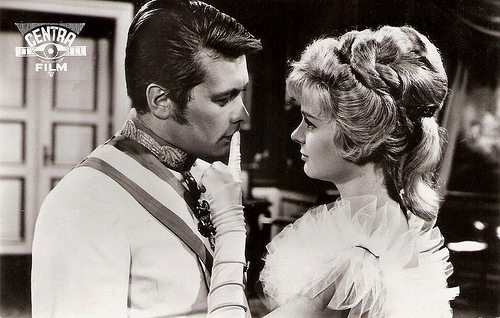
Dutch postcard by SYBA, no. 461. Promotional card for Centrafilm, Den Haag. Publicity still for Die Försterchristel/The Forester's Daughter (Franz Josef Gottlieb, 1962).
Scene from Mariandl (Werner Jacobs, 1961). Source: fritz51263 (YouTube).
Sources: Stephanie D'heil (Steffi-line), Prisma (German), Wikipedia, and .

German postcard by Krüger, no. 902/108. Photo: Bavariafilm. Publicity still for Junge Leute brauchen Liebe/Young People Need Love (Géza von Cziffra, 1961).
Star Maker
Peter Weck was born in Wien (Vienna), Austria, in 1930. At the age of 9, he became a member of the famous Wiener Sängerknaben (Vienna Boy's Choir), where he sang as a soprano soloist till 1940.
From 1949 to 1951, he studied piano, clarinet and bassoon at the Universität für Musik und darstellende Kunst Wien (Academy for Music and Performing Arts, Vienna). He stopped his musical studies and instead decided to become an actor. In 1953, he graduated at the Max Reinhardt Seminar of the same academy in Vienna.
After his stage debut in 1953 as Truffaldino in Carlo Goldoni's Servant of Two Masters at the Stadtheater Klagenfurt. During the 1950s, he also performed in Munich, Hamburg and Vienna. From 1959 till 1970, he played at the renowned Burgtheater in Vienna, where he also worked as a director. Between 1965 and 1976, he also worked for the Schauspielhaus in Zurich.
Like Romy Schneider he was discovered for the cinema by star maker Ernst Marischka. In 1954 he made his film debut in Bruder Martin/Brother Martin (Axel von Ambesser, 1954) with Paul Hörbiger .
Weck was often seen in uniform in costume dramas. Refreshingly natural and without pathos he performed such roles as Prince Heinrich von Oranien in Mädchenjahre einer Königin/The Story of Vickie (Ernst Marischka, 1954), and archduke Carl-Ludwig in Sissi (Ernst Marischka, 1955).
He also appeared in many Heimatfilms of the 1950s like Und der Himmel lacht dazu/And Love Laughs at it (Robert A. Stemmle, 1954), and Die Wirtin zur goldenen Krone/The Innkeeper of the Golden Crown ( Theo Lingen , 1955).
In Die liebe Familie/Dear Family (Helmut Weiss, 1957), he combined boyish charm with energy and common sense. This unusual quality for a jeune premier made him soon the beloved Wiener Goldjungen of the German speaking entertainment cinema.

Dutch postcard. Sent by mail in 1964.

Dutch postcard.
Darling
Peter Weck intensified his film work in the 1960s, and he became a darling of the female public as the sympathetic Filou in Mariandl (Werner Jacobs, 1961) at the side of Conny Froboess .
Peter and Conny were co-stars in a series of Schlagerfilms: Wenn das mein großer Bruder wüßte/When My Big Brother Knew (Erik Ode, 1959), Meine Nichte tut das nicht/My Niece Doesn't Do That (Franz Josef Gottlieb, 1960), Junge Leute brauchen Liebe/Young People Need Love (Géza von Cziffra, 1961), Mariandl (Werner Jacobs, 1961), Der Traum von Lieschen Müller/The Dream of Lieschen Mueller (Helmut Käutner, 1961), Der Vogelhändler/The Bird Seller (Géza von Cziffra, 1962), Mariandls Heimkehr/Mariandl's Return (Werner Jacobs, 1962), and Ist Geraldine ein Engel?/Is Geraldine an Angel? (Steve Previn, 1963).
Stephanie D'heil writes at her website Steffi-line , that the media reported about a relationship between the two young stars, and they even suggested that they were engaged.
But in 1966 Peter Weck met former model Ingrid Muttone in the cafeteria of the Burgtheater. In 1967, she became his wife and they would have two children, Barbara and Philipp Daniel.

Dutch postcard by Int. Filmpers, Amsterdam, no. WPS 168. Photo: Centrafilm. Publicity still for Mariandl (Werner Jacobs, 1961).

Dutch postcard by Uitgeverij Takken, Utrecht, no. AX 4899. Photo: Hafbo Film. Publicity still for Junge Leute brauchen Liebe/Young People Need Love (Géza von Cziffra, 1961).

Dutch postcard by Gebr. Spanjersberg N.V., Rotterdam, no. 1314. Photo: Sascha-Gloria/Ufa.
Pater Familias
One of Peter Weck’s best roles was in The Cardinal (Otto Preminger, 1963) opposite Romy Schneider . He played a Jewish man who became so desperate after the Austrian Anschluss in 1938 that he committed suicide by jumping out of the window.
Later Weck worked in light entertainment films by directors like Franz Antel, Franz Josef Gottlieb, Harald Reinl, and especially Harald Vock.
In 1971 he became very popular as the partner of Fritz Eckhardt in the TV series Wenn der Vater mit dem Sohne/When Fathers and Sons. Another popular series was Ich heirate eine Familie/I Married a Family (1983), which he directed, and in which he also performed the role of the pater familias. The series won the Goldene Kamera award twice, in 1985 and 1986.
From 1983 till 1992 he also worked as the impresario of the Theater an der Wien in Vienna. During this period, the theatre was the location for some important premieres such as the German versions of the musicals Andrew Lloyd Webber's Cats (1983) - which was a huge success, Freudiana (1990) - which he also directed, and Elisabeth (1992). The latter, about the life of Austrian empress Elisabeth (Sissi), was performed in Vienna till 1998, without a break.
In 1993 Weck received the Ehrenkreuz für Wissenschaft und Kunst, Austria's highest decoration for scientists and artists. Many other awards and honours followed.
His last film appearance was in 1999 in the remarkable WWII love story Aimée & Jaguar (Max Färberböck, 1999). But Peter Weck is still working for TV, both as an actor and a director.
Since 1998, Peter Weck is the grandfather of Timon. In 2010, he published his memoirs War's das?: Erinnerungen (Was that it? Memories). Two years later, in 2012, his wife, Ingrid Weck, passed away.
His most recent screen role was in Erinnern/Recall (Michael Riebl, 2013), an episode of the Austrian crime series Schnell ermittelt/Fast Forward (2009-2013). Peter Weck lives in Vienna.

Dutch postcard by SYBA, no. 461. Promotional card for Centrafilm, Den Haag. Publicity still for Die Försterchristel/The Forester's Daughter (Franz Josef Gottlieb, 1962).
Scene from Mariandl (Werner Jacobs, 1961). Source: fritz51263 (YouTube).
Sources: Stephanie D'heil (Steffi-line), Prisma (German), Wikipedia, and .
Published on September 03, 2014 23:00
Paul van Yperen's Blog
- Paul van Yperen's profile
- 13 followers
Paul van Yperen isn't a Goodreads Author
(yet),
but they
do have a blog,
so here are some recent posts imported from
their feed.



